Thank you for choosing Lightware’s HDMI-3D-OPT-DD series devices. In the first chapter we would like to introduce the device highlighting the most important features in the sections listed below:
1.1. Description
HDMI-3D-OPT-DD series transmitter and receiver pair extends HDMI 1.4, DVI 1.0 and RS-232 signals over one multi-mode fiber, and transmits video signal with embedded audio to a distance of up to 2500 meters.
HDMI-3D-OPT-TX210DD transmitter was designed to handle HDMI 1.4 digital video signal and analog stereo audio from local inputs, or HDMI embedded audio from up to eight channel PCM or HBR audio. Analog audio is converted into digital format. The device has a local HDMI video output for monitoring. The video and the embedded audio of the local output is the same as the one transmitted via the OPT link.
HDMI-3D-OPT-RX110DD optical receiver provides extension of uncompressed Full-HD video and audio over one multimode fiber for up to 2500 m. The unit offers an analog audio output, and works at all standard AV resolutions.
HDMI-3D-OPT-DD series extenders offer data diode technology, which means that an optical fiber with a sender on one side and a receiver on the other ensures that data can only be transferred in a forward direction, and never in reverse. This means no two-way transfer, preventing leakage and manipulation from taking place.
Model Denomination
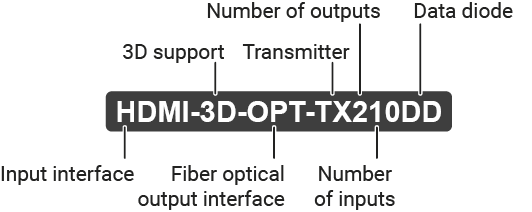
Lightware devices contain a label indicating the unique serial number of the product. The structure is the following:

1.2. Box Contents
The following tables describe all supplied and optional accessories of the HDMI-3D-OPT-DD series extenders by models. The optional (not-supplied) accessories can be purchased separately; please contact sales@lightware.com.
1.2.1. Supplied Accessories
|
HDMI-3D-OPT-TX210DD |
HDMI-3D-OPT-RX110DD |
|||
|
Supplied devices |

|
Transmitter unit |
|
|

|
Receiver unit |
|
|
|
|
Supplied accessories |
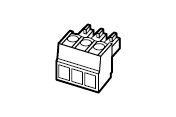
|
Phoenix Combicon® 3-pole connector |
|
|
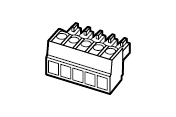
|
Phoenix Combicon® 5-pole connector |
|
|
|
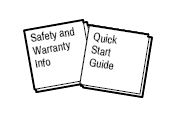
|
Safety and Warranty Info, Quick Start Guide |
|
|
|
1.2.2. Optional Accessories
|
HDMI-3D-OPT-TX210DD |
HDMI-3D-OPT-RX110DD |
|||
|
Optional accessories |
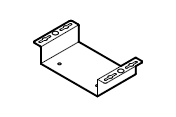
|
Under-desk kit |
|
|
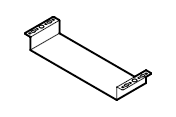
|
Under-desk double kit |
|
|
|
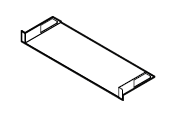
|
1U high rack shelf |
|
|
|

|
UD Mounting Plate F110 |
|
|
|
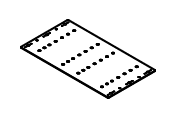
|
UD Mounting Plate F120 |
|
|
|

|
UD Mounting Pro P110 |
|
|
|

|
UD Mounting Pro P140 |
|
|
|
1.3. Compatible Devices
HDMI-3D-OPT-DD series extenders are compatible with each other only.
1.4. Features
General

|
Data Diode Technology |
|
An optical fiber with a sender on one side and a receiver on the other ensures that data can only be transferred in a forward direction, and never in reverse. This means there is no two-way transfer, preventing leakage and manipulation from taking place. |
|

|
3D and 4K Support |
|
High bandwidth allows extension of resolutions of up to 4K, and even 3D sources and displays are supported. |
|

|
Signal Transmission for up to 2500 m |
|
Video and audio signal transmission (DVI, HDMI and RS-232) over one multi-mode fiber optical cable. |
|

|
Single Fiber Technology |
|
HDMI 1.4 signal with 4k@30Hz signal transmission over a single fiber cable. |
|
|
|
Pixel Accurate Reclocking |
|
Each output has a clean, jitter free signal, eliminating signal instability and distortion caused by long cables or connector reflections. |
|

|
Built-in Event Manager |
|
The Event Manager tool takes care of all the necessary control in a smaller configuration by performing predefined actions in response to device status changes. Hence, in a less complex environment, there is no need to invest in additional control solutions, which makes the receiver the best choice for numerous applications. |
|
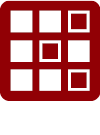
|
LDC |
|
The Lightware Device Controller (LDC) application keeps receiving updates, adding new features and tools. The latest edition of LDC has gotten more intuitive, user friendly, smarter and has a modern user interface. The LDC is available for both Windows and macOS operating systems. |
For Transmitter Only

|
Deep Color Support and Conversion |
|
It is possible to transmit the highest quality 36-bit video streams for perfect color reproduction. |
|

|
Audio Embedding Function |
|
External analog audio signal can be embedded in the video stream. |
For Receiver Only

|
Audio De-Embedding Function |
|
Embedded audio signal can be de-embedded from the video stream to analog audio ports. |
1.5. Typical Application

The following sections are about the physical structure of the device, input/output ports and connectors; software and hardware capabilities:
2.1.1. Front View

|
|
USB connector |
USB interface for LDC connection and firmware update purpose. |
|||
|
USB LED |
|||||

|
off |
USB is disconnected, or there is no USB data transfer over the port. |
|||

|
blinking |
Device control mode is active. |
|||
|
|
HDMI input |
HDMI connector for DVI video or HDMI video and audio signals. The port supports DVI 1.0 and HDMI 1.4 standards. |
|||
|
Video source LED |
|||||

|
off |
Video source is not connected. |
|||

|
on |
Video source is active. |
|||

|
blinking |
Video source is connected, but no signal is detected. |
|||
|
Audio source LED |
|||||

|
off |
Audio source is not selected. |
|||

|
blinking |
Audio source is selected, but no signal is detected (digital inputs only). |
|||

|
on (with short pause) |
Audio source is selected and the port is active, but not embedded into the output video stream (DVI output mode). |
|||

|
on (continuously) |
Audio source is selected, the port is active, and the audio is embedded into the output video stream (HDMI output mode). |
|||
|
|
Audio1 input |
3.5 mm Jack connector for asymmetric analog audio input signal. |
|||
|
AUDIO1 LED |
|||||

|
off |
Audio source is not selected. |
|||

|
blinking |
Audio source is selected, but no signal is detected (digital inputs only). |
|||

|
on (with short pause) |
Audio source is selected and the port is active, but not embedded into the output video stream (DVI output mode). |
|||

|
on (continuously) |
Audio source is selected, the port is active, and the audio is embedded into the output video stream (HDMI output mode). |
|||
|
|
Reset button |
Reboots the device (the same as disconnecting from the power source and reconnecting again). |
|||
|
|
Audio Select button |
Button for switching between audio sources. See the details in the Audio Select Button section. |
|||
|
|
Audio2 status LED |
The LED gives feedback about the actual connection status of the Audio2 input port (located on the rear side of the device). |
|||
|
AUDIO2 LED |
|||||

|
off |
Audio source is not selected. |
|||

|
blinking |
Audio source is selected, but no signal is detected (digital inputs only). |
|||

|
on (with short pause) |
Audio source is selected and the port is active, but not embedded into the output video stream (DVI output mode). |
|||

|
on (continuously) |
Audio source is selected, the port is active, and the audio is embedded into the output video stream (HDMI output mode). |
|||
|
|
Show Me button |
Special functions are available via this button (switch to bootload mode, restore factory default settings, condition launching in Event Manager). For the details about special functions, see the Special Functions of the Transmitter section. |
|||
2.1.2. Rear View

|
|
SC fiber output |
Connect a multimode single fiber optical cable between the transmitter and the receiver unit. Maximum fiber cable distances can be found in the Maximum Fiber Cable Extensions section. |
|||
|
|
Audio2 input |
5-pole Phoenix connector for balanced analog audio input signal. The pin assignment can be found in the Analog Stereo Audio Connector (5-pole Phoenix) section, the wiring guide can be found in the Cable Wiring Guide section. |
|||
|
|
HDMI output |
Local HDMI output with the same AV content as the fiber optical output. |
|||
|
|
Status LEDs |
The LEDs give immediate feedback about the actual state of the device. |
|||
|
LIVE |
|||||

|
off |
Device is not powered. |
|||

|
blinking (green) |
Device is powered and operational. |
|||

|
blinking (red) |
Alert detected. |
|||

|
blinking (yellow) |
Device is in firmware update (bootload) mode. |
|||

|
on (yellow) |
Device is powered, but not operational. |
|||
|
LASER ACTIVE |
|||||

|
on |
Laser transmission is enabled. |
|||
|
|
RS-232 |
3-pole Phoenix connector for RS-232 serial communication. The pin assignment can be found in the RS-232 Connector section, the wiring guide can be found in the Cable Wiring Guide section. |
|||
|
|
5V DC input |
Connect the output of the supplied 5V DC power adaptor. For more information, see the 5V DC Connection section. |
|||
2.2.1. Front View

|
|
Power LED |
The LED indicates the power status of the device. |
|||

|
off |
Device is not powered. |
|||

|
on |
Device is powered and operational. |
|||
|
|
USB Control |
USB interface for LDC connection and firmware update purpose. |
|||
|
|
Function button |
Factory default settings and bootload mode can be recalled using the button. See the details in the Special Functions of the Receiver section. |
|||
|
|
Status LEDs |
The LEDs give immediate feedback about the actual state of the device. |
|||
|
HDMI |
|||||

|
off |
The input signal type is DVI. |
|||

|
blinking |
The input signal type is HDMI, but the output signal is DVI. |
|||

|
on |
The input and output signal type is HDMI. |
|||
|
SIGNAL |
|||||

|
on |
Valid video clock signal is present on the fiber input port of the receiver. |
|||
|
HOTPLUG |
|||||

|
on |
Powered sink device is connected to the HDMI OUT port and sends hotplug signal. |
|||
2.2.2. Rear View

|
|
5V DC input |
Connect the output of the supplied 5V DC power adaptor. For more information, see the 5V DC Connection section. |
|
|
SC fiber input |
Connect a multi-mode single fiber optical cable between the receiver and the transmitter. |
|
|
Analog audio output |
5-pole Phoenix connector for balanced analog audio output signal. The pin assignment can be found in the Analog Stereo Audio Connector (5-pole Phoenix) section, the wiring guide can be found in the Cable Wiring Guide section. |
|
|
HDMI output |
HDMI connector for DVI video or HDMI video and audio signals. The port supports DVI 1.0 and HDMI 1.4 standards. |
2.3. Front Panel Buttons of the Transmitter

Desired audio input can be selected by the Audio Select button from the front panel. The selection order of the inputs is described on the right.

#button #frontpanel
2.3.2. Programmable Show Me Button

Action or an operation can be assigned to the Show Me button. “Show Me button pressed” is a condition that can be selected in the Event Manager. See more details in the Event Manager section.
#showme
2.4. Special Functions of the Transmitter
2.4.1. Recalling Factory Defaults Settings

To restore factory default values, do the following steps:
Step 1.Make sure the device is powered on and operational.
Step 2.Press, and keep pressing the Show Me button for 10 seconds. After 5 seconds the front panel LEDs start blinking, but keep on pressing the button.
Step 3.After 10 seconds the LEDs start blinking faster; release the button and press it 3 times again quickly (within 3 seconds).
Step 4.The LEDs get dark, the device restores the Factory Default Settings and reboots.
#factory
2.4.2. Control Lock

Press the Audio Select and Show Me buttons together (within 100 ms) to disable/enable the front panel buttons; the front panel LEDs blink 4 times when locking/unlocking. If the control lock is enabled and a button is pressed, the front panel LEDs blink 3 times quickly.
Control lock can be deactivated in the Lightware Device Controller (LDC) software (see the details in the Status section), or via LW3 protocol command (see the details in the Lock the Front Panel Buttons section).
#controllock #lockbutton
2.4.3. Resetting the Device

In a few cases (after firmware update, etc) you may need to reset the device. Pushing the reset button gives the same result as disconnecting and reconnecting the power adaptor to the transmitter. To reset the device, follow the steps:
Step 1.Push the button with a thin object for a second.
Step 2.Wait until the device reboots. You can use the transmitter when the LIVE LED is blinking slowly again.
ATTENTION!Resetting the device does not restore the settings to factory defaults. To restore the factory default setting, see the previous section.
#reset #reboot #restart
2.4.4. Entering Firmware Update Mode

It may happen that the firmware update process is not successful, and the device cannot be switched to bootload mode automatically. In this case, the device can be forced into firmware update mode as follows:
Step 1.Make sure the transmitter is powered off.
Step 2.Press, and keep pressing the Show Me button.
Step 3.Power on the transmitter while the Show Me button is being pressed. If the device is switched to firmware update mode, the LIVE LED is blinking quickly (less than 500 ms duty cycle). The other LEDs are off.
#bootload
2.5. Special Functions of the Receiver
2.5.1. Recalling Factory Default Settings

To restore factory default values, do the following steps:
Step 1.Make sure the device is powered on and operational.
Step 2.Press, and keep pressing the Function button for 10 seconds. After 5 seconds the front panel LEDs start blinking, but keep on pressing the button.
Step 3.After 10 seconds the LEDs start blinking faster; release the button and press it 3 times again quickly (within 3 seconds).
Step 4.The LEDs get dark, the device restores the Factory Default Settings and reboots.
#frontpanel #button #function #factory
2.5.2. Entering Firmware Update Mode

It may happen that the firmware update process is not successful, and the device cannot be switched to bootload mode automatically. In this case, the device can be forced into firmware update mode as follows:
Step 1.Make sure the receiver is powered off.
Step 2.Press, and keep pressed the Function button.
Step 3.Power on the receiver while the Function button is being pressed. If the device is switched to bootload mode, the Status LEDs are blinking quickly (less than 500 ms duty cycle).
#bootload
This chapter is about the installation of the device and connecting to other appliances, also presenting the mounting options and further assembly steps.
3.1. Mounting Options
To mount the transmitter, Lightware supplies optional accessories for different usage. There are two kinds of mounting kits with a similar fixing method. The device has two mounting holes with inner thread on the bottom side; see the bottom view in the Mechanical Drawings section. Fasten the device with the screws enclosed to the accessory:

|
|
|
1U high rack shelf |
|

|

|
|
Under-desk mounting kit |
Under-desk double mounting kit |
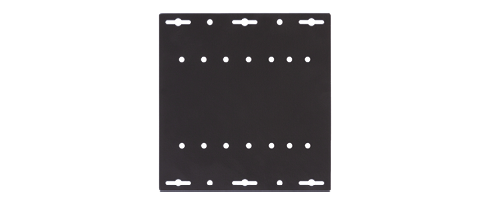
|
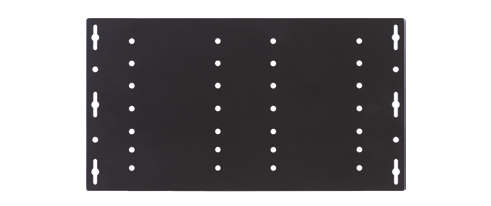
|
|
UD Mounting Plate F110 |
UD Mounting Plate F120 |

|

|
|
UD Mounting Pro P110 |
UD Mounting Pro P140 |
The Under-desk double mounting kit makes it easy to mount a single device on any flat surface, e.g. furniture. The 1U high rack shelf provides mounting holes for the fastening of up to two half-rack or four quarter-rack sized units. Pocket-sized devices can also be fastened to the shelf. To order mounting accessories, please contact sales@lightware.com.
WARNING!Always use the supplied screws. Using different (e.g. longer) ones may cause damage to the device.
INFO:The transmitters are half-rack sized, the receiver is quarter-rack sized.
More details about the accessories and the mounting can be found in the Mounting Assembly Guide.
3.1.1. Rack Shelf Mounting
1U High Rack Shelf

Allows rack mounting for half-rack, quarter-rack and pocket sized units.
The 1U high rack shelf provides mounting holes for the fastening of up to two half-rack or four quarter-rack sized units. Pocket sized devices can also be fastened to the shelf.
Under-Desk Mounting Kit
The UD kit allows a receiver to be easily mounted on any flat surface (e.g. furniture).
ATTENTION!Only quarter-rack sized units (HDMI-3D-OPT-RX110DD receiver) can be installed to the kit.

INFO:The chipboard screws are not supplied with the mounting kit.
Under-Desk Double Mounting Kit
The UD-kit double makes it easy to mount a single transmitter or multiple receivers on any flat surface (e.g. furniture).

INFO:The chipboard screws are not supplied with the mounting kit.
Under-Desk Mounting Plates
|
Accessory |
Number of mountable devices |
Features |
|
|
UD Mounting Plate F110 |

|
1 quarter-rack sized |
Lightweight design |
|
UD Mounting Plate F120 |

|
2 quarter-rack sized or 1 half-rack sized |
Lightweight design |
|
UD Mounting Pro P110 |

|
1 quarter-rack sized |
Easy to change the mounted device |
|
UD Mounting Pro P140 |

|
2 quarter-rack sized or 1 half-rack sized |
Easy to change the mounted devices |
INFO:For more details about the options of the applications and the assembly steps, please download the Mounting Accessory Guide from our website: https://lightware.com/pub/media/lightware/filedownloader/file/Assembly-Guide/Mounting_AG.pdf

Locking DC connector
The extenders are built with locking 5V DC connector. Do not forget to turn the plug clockwise direction before disconnecting the power adaptor.
WARNING!Always use the supplied 5V power adaptor. Warranty void if damage occurs due to use of a different power source.

The extenders provide standard 19-pole HDMI connectors for input and output. The port supports DVI 1.0 and HDMI 1.4 standards both in case of the transmitter and the receiver. Always use high-quality HDMI cable for connecting sources and displays.
3.2.3. SC Fiber Optical Connector

HDMI-3D-OPT-DD series transmitter and receiver provide multimode SC fiber optical input and output connectors.
Maximum fiber cable distances can be found in the Maximum Fiber Cable Extensions section.
WARNING!Please do not look directly into the SC fiber optical connector if the cable is connected to the transmitter only and the laser is active.
3.2.4. Analog Stereo Audio Connector (3.5 mm Jack)

The connector is used for receiving unbalanced analog audio signal. It is also known as (3.5 mm or approx. 1/8”) audio jack, phone jack, phone plug and mini-jack plug.

Jack audio plug pin assignments
You can find more information about audio functions in the Audio Interface section.
3.2.5. Analog Stereo Audio Connector (5-pole Phoenix)
The 5-pole Phoenix connector is used for balanced analog audio output. Unbalanced audio signals can be connected as well. For unbalanced output, connect + and ground to the source and connect – to the ground.

Analog audio connector and plug pin assignments
Compatible Plug Type
Phoenix® Combicon series (3.5mm pitch, 5-pole), type: MC 1.5/5-ST-3.5.
You can find more information about analog audio functions in the Audio Interface section. Audio cable wiring guide is in the Cable Wiring Guide section.
HDMI-3D-OPT-TX210DD transmitter contains a 3-pole Phoenix connector, which is used for RS-232 serial connection.

RS-232 connector pin assignments
Compatible Plug Type
Phoenix® Combicon series (3.5mm pitch, 3-pole), type: MC 1.5/3-ST-3.5.
Guide for the correct wiring can be found in the Cable Wiring Guide section.
3.2.7. USB Mini Connector

The extenders provide a standard USB mini B-type connector for software control and firmware update purposes.
3.3. Connecting Steps

|
Transmitter Side |
|
|
|
Connect the transmitter and the receiver using a multimode single fiber optical cable. |
|
|
Connect the source (e.g. a Blu-ray player) to the input port of the transmitter by a HDMI cable. |
|
|
Optionally connect an assymmetric audio device with unbalanced audio signal (e.g. an MP3 player) to the 2.5" TRS (jack) audio input port. |
|
|
Optionally connect a symmetric audio device with balanced audio signal (e.g. a media player) to the 5-pole Phoenix audio input port. See the Cable Wiring Guide for the correct wiring. |
|
|
Connect the local sink device (e.g. a monitor) to the HDMI output port by an HDMI cable. |
|
|
Optionally for USB control: connect the transmitter to the computer by the USB mini B-type cable. |
|
|
Optionally for RS-232 control: connect a controller device (e.g. a touch panel) to the RS-232 port. |
|
|
Connect the power adaptor to the DC input of the transmitter first, then to the AC power socket. |
|
Receiver Side |
|
|
|
Connect the receiver and the transmitter board using a multimode single fiber optical cable. |
|
|
Connect the sink device (e.g. a projector) to the HDMI output port by an HDMI cable. |
|
|
Optionally connect an analog audio device with balanced audio signal (e.g. active speakers) to the 5-pole Phoenix audio output port. See the Cable Wiring Guide for the correct wiring. |
|
|
Optionally for USB control: connect the receiver to the controller device (e.g. laptop) by a USB mini B-type cable. |
|
|
Connect the power adaptor to the DC input of the receiver first, then to the AC power socket. |
ATTENTION!HDMI-3D-OPT-DD series extenders are compatible only with each other.
The following chapter describes the features of the device with a few real-life examples. The topics that are described:
4.1. Data Diode Extender Concept
Data Diode Technology
DEFINITION:A data diode (also referred to as unidirectional gateway, deterministic one-way boundary device or unidirectional network) is a network appliance or device allowing data to travel only in one direction. 1
An optical fiber with a sender on one side and a receiver on the other ensures that data can only be transferred in a forward direction, and never in reverse. This means there is no two-way transfer, preventing leakage and manipulation from taking place.
If a data diode is directed out from a high security network towards a network with a lower security level, data can be transferred while the network stays protected. By transferring information via a data diode, you are guaranteed that no one can use the same connection in the opposite direction to reach the secure network and manipulate its environment. 2
1 Source: https://csrc.nist.gov/glossary/term/data_diode
2 Source: https://advenica.com/en/blog/2019-02-19/what-is-a-data-diode-and-how-does-it-work
4.1.1. Transmitter Concept
HDMI-3D-OPT-TX210DD transmitter has a multimode single fiber output interface, which is able to transmit different type of signals at the same time. The transmitter accepts digital video HDMI) and analog audio sources (Jack and 5-pole Phoenix). The device can be controlled over RS-232 (3-pole Phoenix) and USB interfaces.
Port Diagram

Port diagram of the AV interfaces for HDMI-3D-OPT-TX210DD transmitter
4.1.2. Receiver Concept
HDMI-3D-OPT-RX110DD receiver has a multi-mode single fiber input interface, which is able to receive different types of signals at the same time. The device accepts digital video and digital/analog audiosignals over a single fiber cable. The device is able to de-embed the audio signal to the analog (5-pole Phoenix) port, and transmit it to the audio source device. The unit can be controlled via USB interface (USB mini B-type).
Port Diagram

Port diagram of the AV interfaces for HDMI-3D-OPT-RX110DD receiver
4.2. Video Interface
The transmitter is able to receive digital video signal over the HDMI input port. Supported AV standards are DVI 1.0 and HDMI 1.4 with up to 4096x2160@30Hz resolution.
The digital video signal with the embedded digital audio is transmitted to the receiver over the multimode fiber optical interface. See the maximum fiber cable distances in the Maximum Fiber Cable Extensions section.
The receiver can receive the AV signal over the fiber optical interface and transmits it to the HDMI output port. Supported AV standards are DVI 1.0 and HDMI 1.4 with up to 4096x2160@30Hz resolution.
4.3.1. Audio Inputs and Modes - Transmitter
The transmitter can receive audio from two type of sources:
▪Embedded (over HDMI port);
▪Analog audio sources (over 3,5mm Jack and 5-pole Phoenix ports).
Audio signal coming from the analog inputs can be assigned to the video input as embedded audio. The gain levels of the analog audio input and the volume of the analog audio output ports are adjustable.
Audio Embedding – Allowed Connections
When the desired video signal is selected, the audio of the transmitted signal can be:
▪Audio of the original signal, or
▪Analog audio signal.
4.3.2. Audio Outputs and Modes - Receiver
The receiver can transmit audio on three types of audio ports:
▪Embedded (over HDMI port);
▪Analog balanced audio (over 5-pole Phoenix port).
The digital audio signal coming from the the optical input port can be transmitted on any audio output ports: HDMI or the analog audio output port. The volume and balance levels are adjustable on the analog output port.
Supported Audio Formats
The table below shows the supported audio formats by output ports.
|
Audio formats |
Audio outputs |
|
|
Embedded audio |
Analog audio output |
|
|
Multichannel PCM |
Max 8 channel |
Stereo PCM |
|
Dolby Digital 2.1 |
|
- |
|
Dolby Digital 5.1 |
|
- |
|
Dolby Digital 7.1 |
|
- |
|
DTS 2.1 |
|
- |
|
DTS 5.1 |
|
- |
|
DTS 7.1 |
|
- |
|
Dolby TrueHD (HBR) |
|
- |
|
DTS-HD (HBR) |
|
- |
|
DTS-HD Master Audio (HBR) |
|
- |
|
All other HDMI specified standards |
|
- |
4.3.3. Audio Signal Routing - Example
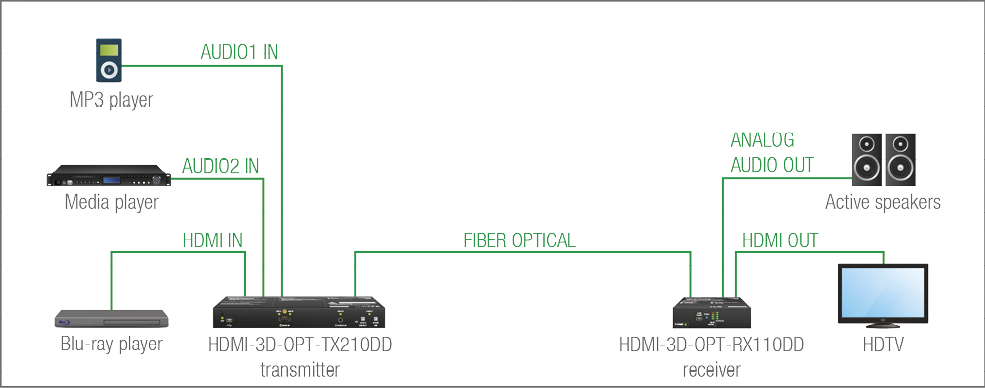
The Concept
Two audio source devices are connected to the trasmitter: a Blu-ray player, which has embedded digital audio on HDMI; and a media player, which sends analog audio to the transmitter. On the receiver's side there are two audio source devices: an HDTV, which can receive digital audio on HDMI; and an audio amplifier, which can receive analog or digital audio signals as well.
As the transmitter is able to embed the analog audio signal into the HDMI signal, the user can transmit audio from three type of sources:
▪analog audio of the MP3 player;
▪analog audio of the media player;
▪or the embeded digital audio of the Blu-ray player.
INFO:One audio (embedded or analog) and one video signal can be transmitted via the optical output at the same time.
The receiver has a built-in de-embedder function, so user can transmit audio signal to:
▪the active speakers;
▪and the HDTV as well.
All related audio settings are available in the Lightware Device Controller (LDC) software, see the Port Properties Windows section.

DIFFERENCE:Autoselect feature is available for the audio ports only.
Beside the manual selection of crosspoints, you can choose the Autoselect option in case of audio ports.
There are three types of Autoselect as follows.
▪First detect mode: selected input port is kept connected to the output while it has an active signal.
▪Priority detect mode: always the highest priority active input is selected to transmit.
▪Last detect mode: always the last attached input is selected to transmit.
Flowchart of Autoselection modes
Automatic Input Selection - Example

The Concept
If there is no other audio source connected to the transmitter but the MP3 player, AUDIO1 IN input will be automatically switched to the optical output. If the MP3 player and the media player are also connected to the transmitter, AUDIO2 IN input will be switched to the optical output. If the Blu-ray player is connected on the HDMI input of the transmitter, it will be switched to the optical output – independently from the presence of other video signals.
Settings
▪Optical output: Set the Autoselect to Enabled. Set Autoselect mode to Priority detect. The priorities are the following (the lowest number means the highest priority):
|
Source device |
Input port |
Priority |
|
MP3 player |
I2 (AUDIO1 IN) |
2 |
|
Media player |
I3 (AUDIO2 IN) |
1 |
|
Blu-ray player |
I1 (HDMI IN) |
0 |
Priorities can be set in Lightware Device Controller (LDC) software (see related settings in the Autoselect Feature section), via LW2 protocol command (see related settings in the Change the Audio Input Priorities section) and via LW3 protocol command (see related settings in the Change the Input Port Priority section).
4.5. Control Interfaces
HDMI-3D-OPT-DD series extenders can be managed and supervised over two types of interfaces:
▪USB (via USB mini B-type connector) - both in case of the transmitter and the receiver;
▪RS-232 (via 3-pole Phoenix connector) - in case of the transmitter only.
Software Control Modes
The user has more possibilities to control the device remotely. The following list contains the software control modes:
▪Lightware Device Controller (LDC) - you can connect to the device via our control software using Ethernet interface, and control or configure the device as you wish. For the details, see the Software Control - Lightware Device Controller chapter.
▪LW2 protocol commands: you can configure the device by using the reduced command set of LW2 protocol. For more details, see the LW2 Programmer's Reference chapter.
▪LW3 protocol commands: you can configure the device by using the full-range command set of LW3 protocol. For more details, see the LW3 Programmer's Reference chapter.
4.6. Further Built-in Features
4.6.1. Automatically Launched Actions - The Event Manager

The Event Manager feature means that the device can sense changes on its ports, and is able to react according to the pre-defined settings. Lightware Device Controller contains a user-friendly software tool and allows the creation of Events by defining a Condition and an Action.

Event Manager example
See more information about the settings in the Event Manager section.
4.6.2. Device Cloning – Configuration Backup and Restore

Configuration cloning of HDMI-3D-OPT-DD series extenders is a simple method that eliminates the need to repeatedly configure certain devices to have identical (non-factory) settings. If the devices are installed in the same type of system multiple times then it is enough to set up only one device to fit the user’s needs and then copy those settings to the others, thus saving time, and resources.
See more information about the settings in the Configuration Cloning (Backup Tab) section.
4.6.3. Advanced EDID Management
Factory Preset EDIDs
The factory EDIDs (F1-F136) are factory preprogrammed and cannot be modified. These are the most common signal formats. They are specially provided to force graphic cards to output only the exact pixel resolution and refresh rate.
Universal EDID allows multiple resolutions, including all common VESA defined resolutions. The use of universal EDID is recommended for fast and easy system setup.
Sources and Destinations
The EDID memory consists of four parts:
▪Factory EDID list shows the pre-programmed EDIDs (F1-F136).
▪Dynamic EDID list shows the sink connected to the outputs of the device. The unit stores the last display devices’ EDID on either output, so there is an EDID shown even if there is no display device attached to the output port at the moment.
▪User memory locations (U1 – U14 for the transmitter; U1 – U15 for the receiver) can be used to save custom EDIDs.
▪Emulated EDID list shows the currently emulated EDID for the inputs. The source column displays the memory location that the current EDID was routed from.
The source reads the EDID from the Emulated EDID memory on the input port. Any EDID from any of the User/Factory/Dynamic EDID lists can be copied to the user memory.
HDMI-3D-OPT-DD series extenders applies static emulation: an EDID from the Factory or User EDID list is selected. Thus, the Emulated EDID remains the same until the user emulates another EDID.
See more information about the settings in the EDID Menu section in the LDC software.
5. Software Control - Lightware Device Controller
The device can be controlled by a computer through USB or RS-232 interfaces with the Lightware Device Controller (LDC). The software can be installed on a Windows PC or macOS. The application and the User’s Manual can be downloaded from www.lightware.com.
INFO:After the installation, the Windows and the macOS applications have the same look and functionality.
Minimum System Requirement
RAM: 1 GB
Minimum display resolution: 1280x720
Installation for Windows OS
Run the installer. If the User Account Control drops a pop-up message, click Yes.
During the installation you will be prompted to select the type of the installation: normal and the snapshot install:
|
Normal install |
Snapshot install |
|
Available for Windows and macOS |
Available for Windows |
|
The installer can update only this instance |
Cannot be updated |
|
Only one updateable instance can exist for all users |
More than one different version can be installed for all users |
Comparison of installation types
ATTENTION!Using the Normal install as the default choice is highly recommended.
Installation for macOS
Mount the DMG file by double clicking on it, and drag the LDC icon over the Applications icon to copy the program into the Applications folder. If you want to copy the LDC into another location, just drag the icon over the desired folder.
ATTENTION!Please check the firewall settings on the macOS device. LDC needs to be added to the exeptions of the blocked software for the proper operation.
Updating LDC
Step 1.Run the application.
The Device Discovery window appears automatically and the program checks the available updates on Lightware’s website, and opens the update window if LDC updates are found.
The current and the update version number can be seen at the top of the window, and they are shown in this window even with the snapshot install.
The Update window can also be opened by clicking on the About  icon and the Update button.
icon and the Update button.
Step 2.Set the desired update setting in the Options section.
▪If you do not want to check for the updates automatically, uncheck the circle that contains the green tick.
▪If you want to postpone the update, a reminder can be set with different delays from the drop down list.
▪If the proxy settings traverse the update process, set the proper values then click on the OK button.
Step 3.Click the Download update button to start the updating.
The updates can be checked manually by clicking on the Check now button.
5.2. Establishing the Connection
Step 1.Connect the device to a computer via RS-232 or USB.
Step 2.Run the controller software; the device discovery window appears automatically.
Import/Export the List of Favorite Devices
DIFFERENCE:This feature is available only from LDC version v2.5.5.
The list of favorite devices can be exported/imported with the dedicated buttons (saved as *.JSON file). The list can be imported later (in another computer, too), but please note that the current list will be overwritten by the imported list.
5.2.1. Serial Tab
If the device is connected via the RS-232 port, click on the Query button next to the desired serial port to display the device’s name and serial number. Double-click on the device or select it and click on the green Connect button.

ATTENTION!Before the device is connected via the local RS-232 port, make sure that LW3 protocol is set on the serial port. Furthermore, the RS-232 port must be free and other serial connection must not be established to the device over that port.
Factory Default Values for RS-232 Port
BAUD rate: 57600
Data bits: 8
Parity: No
Stop bits: 1
5.2.2. USB Tab
Connect the device to a PC/computer over the USB mini-B type connector. Refresh the list and double-click on the device or select it and click on the green Connect button.
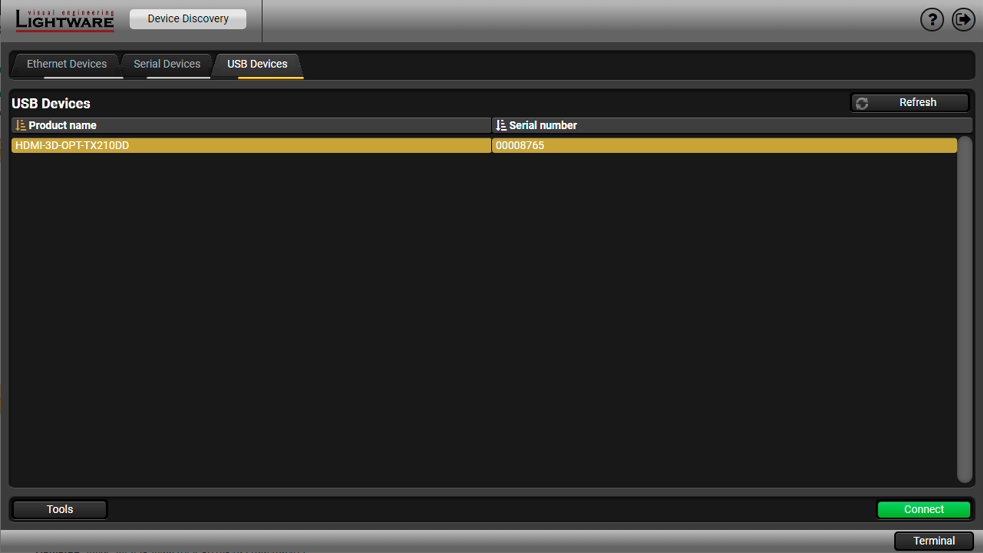
5.2.3. Further Tools
The Tools menu contains the following options:
▪Log Viewer: The tool can be used for reviewing log files that have been saved previously.
▪Create EDID: This tool opens the Easy EDID Creator wizard, which can be used for creating unique EDIDs in a few simple steps. Functionality is the same as that of the Easy EDID Creator.
▪Demo Mode: This is a virtual MX-FR17 matrix router with full functionality built into the LDC. Functions and options are the same as that of the real MX-FR17 device.
The Terminal window is also available by pressing its button on the bottom.

|
|
Main menu |
The available menu items are displayed. The active one is showed with dark grey background color.#crosspoint #switch |
|
|
Information ribbon |
The label shows the device label that can be edited in the Settings menu - Status tab. Device discovery window can be displayed by clicking on this ribbon. |
|
|
Video input ports |
Each tile represents a video input port. The tile below the port shows the current crosspoint setting; if the port is switched to the output, the color of the tile is white, otherwise grey. |
|
|
Audio input ports |
Each tile represents an audio input port. The tile below the port shows current crosspoint setting; if the port is switched to the output, the color of the tile is white, otherwise grey. Dark grey means the audio port is not allowed to embed in the current video input port. |
|
|
Audio Connections |
The audio crosspoint connections can be selected in this table. |
|
|
Advanced view |
Displaying the Advanced View (Terminal Window), showing the Terminal window and the LW3 protocol tree. |
|
|
Audio output ports |
The audio output of the optical link and local HDMI out ports. Clicking on the tile opens the Port Properties Windows. |
|
|
Video output ports |
The video output of the optical link and local HDMI out ports. Clicking on the tile opens the Port Properties Windows. |
Port Tiles
The colors of the port tiles and the displayed icons represent different states and information:

|
|
Port name |
|
|
Port icon |
|
|
Port number |
|
|
Signal present indicator green: present grey: not present |
|
|
State indicators |
State Indicators
The following icons display different states of the port/signal:
|
Icon |
Icon is grey |
Icon is black |
Icon is green |
|
|
Port is unmuted |
Port is muted |
- |
|
|
Port is unlocked |
Port is locked |
- |
|
|
Autoselect is disabled |
- |
Autoselect is enabled |
Clicking on the port tile opens the Port properties window. This section shows the available settings and status information by port types. #status #portstatus #mute #unmute #lock #unlock
Clicking on the HDMI1 video input port icon opens the Port properties window. You can find the most important information and settings in the panel.

Port properties window of the HDMI video input
Available settings:
▪Mute/unmute the port;
▪Lock/unlock the port;
▪Reloading factory default settings for the selected port.
Clicking on the HDMI audio input port icon opens the Port properties window. You can find the most important information and settings in the panel.

Port properties window of the HDMI audio input
Certain parameters of the embedded audio input signal can be set as follows:
▪Mute/unmute the port;
▪Lock/unlock the port;
▪Reloading factory default settings for the selected port.
5.4.3. Analog Audio Inputs (TX)
Clicking on the Audio1 (3.5mm Jack) or Audio2 (3-pole Phoenix) audio input port icon opens the Port properties window. You can find the most important information and settings in the panel:
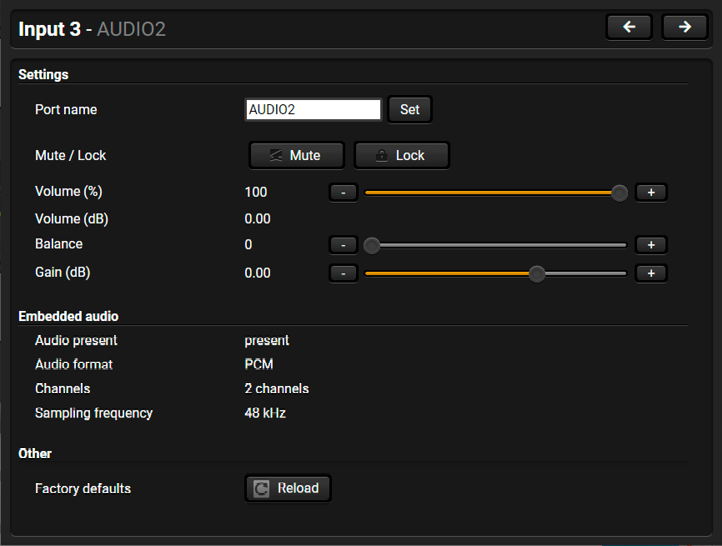
Port properties window of the Analog Audio 2 (Phoenix) input
Certain parameters of the analog audio input signal can be set as follows:
▪Mute/unmute the port;
▪Lock/unlock the port;
▪Volume: from 0 dB to -95.62 dB, in step 0.375 dB (default is 0 dB);
▪Balance: from 0 to 100, in step 1 (default is 50 = center);
▪Gain: -12 to 6 dB, in step 3 dB (default is 0 dB);
▪Reloading factory default settings for the selected port.
#audio #analogaudio #volume #balance #gain
Click on the LINKOUT output port to display the port properties. You can find the most important information and settings in the panel.

Port properties window of the optical video output
Available settings:
▪Signal type: Auto / DVI / HDMI - The outgoing signal format can be selected from a drop-down menu;
▪Laser enable:
=On: high-speed (AV signal) and low-speed (serial, USB) communications are transmitted.
=Standby: only low-speed (serial, USB) communication is transmitted.
▪Test pattern: configuration settings of the test pattern. See more details in the Test Pattern section.
▪Reloading factory default settings for the selected port.
#optical #signaltype
5.4.5. Local Video Output
Click on the Local HDMI output port to display the port properties. You can find the most important information and settings in the panel. #signaltype
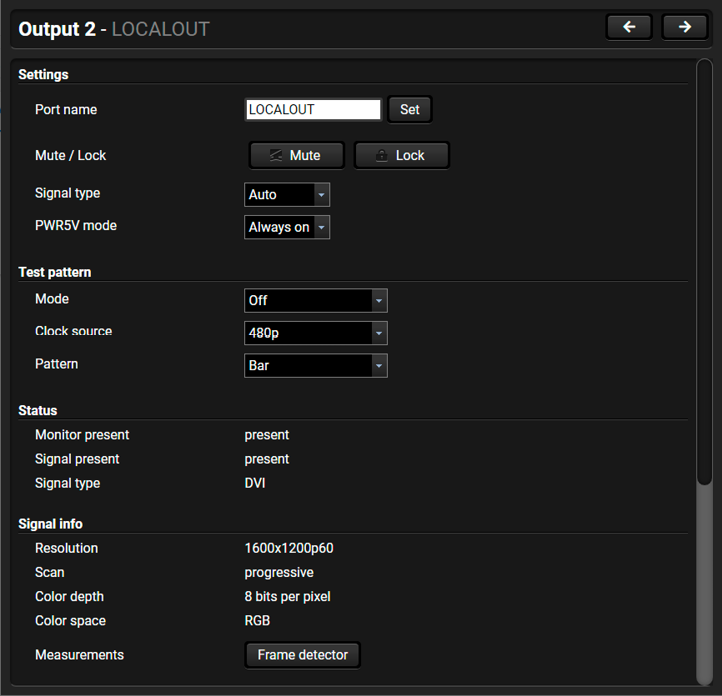
Port properties window of the optical video output
Available settings:
▪Mute/unmute the port;
▪Lock/unlock the port;
▪Signal type: Auto / DVI / HDMI - The outgoing signal format can be selected from a drop-down menu;
▪Power 5V mode: Auto / Always on / Always off - The setting lets the source and the sink devices be connected – independently from the transmitted signal;
▪Test pattern: configuration settings of the test pattern. See more details in the Test Pattern section.
▪Reloading factory default settings for the selected port.
5.4.6. Digital Audio Output
Click on the output port to display its properties. You can find the most important information and settings in the panel.

Port properties window of the optical link audio output
Available settings:
▪Mute/unmute the port;
▪Lock/unlock the port;
▪Autoselect settings: enable / disable, mode, and priorities. (See more details about the feature in the next section below);
▪Reloading factory default settings for the selected port.
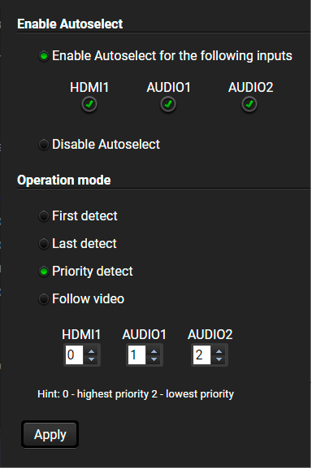
Clicking on the Autoselect Configure button on one of the output port properties windows opens the Autoselect feature configurator. Pay attention to the following settings for the proper operation of Autoselect function: #autoselect
▪Set the Autoselect settings to be enabled for the desired input ports;
▪Set the desired Operation mode (see more details about it in The Autoselect Feature section);
▪Set the priority number in the case of Priority detect operation mode.
▪Always click on the Apply button after the changes to launch the new settings.
5.4.8. Analog Audio Output (RX)
DIFFERENCE:Only HDMI-3D-OPT-RX110DD model is built with an analog audio output port.
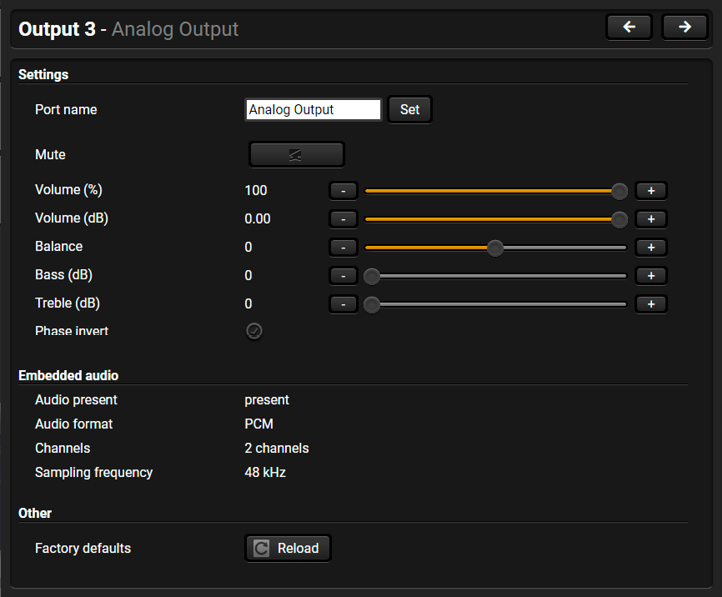
Port properties window of the analog audio output of the receiver
Certain parameters of the analog audio input signal can be set as follows:
▪Mute/unmute the port;
▪Volume: from 0 dB to -63.00 dB, in step 1.00 dB (default is 0 dB);
▪Balance: from 0 to 100, in step 1 (default is 50 = center);
▪Bass: from 0 dB to 24.00 dB, in step 2.00 dB (default is 0 dB);
▪Treble: from 0 dB to 6.00 dB, in step 2.00 dB (default is 0 dB);
▪Phase invert switcher;
▪Reloading factory default settings for the selected port.
#audio #analogaudio #volume #balance
5.5. Diagnostic Tools
The ports can show detailed information about the signal, like full size and active video resolution. This feature is a good troubleshooter if compatibility problems occur during system installation. To access this function, open the port properties window and click on the Frame detector button. #framedetector #diagnostic
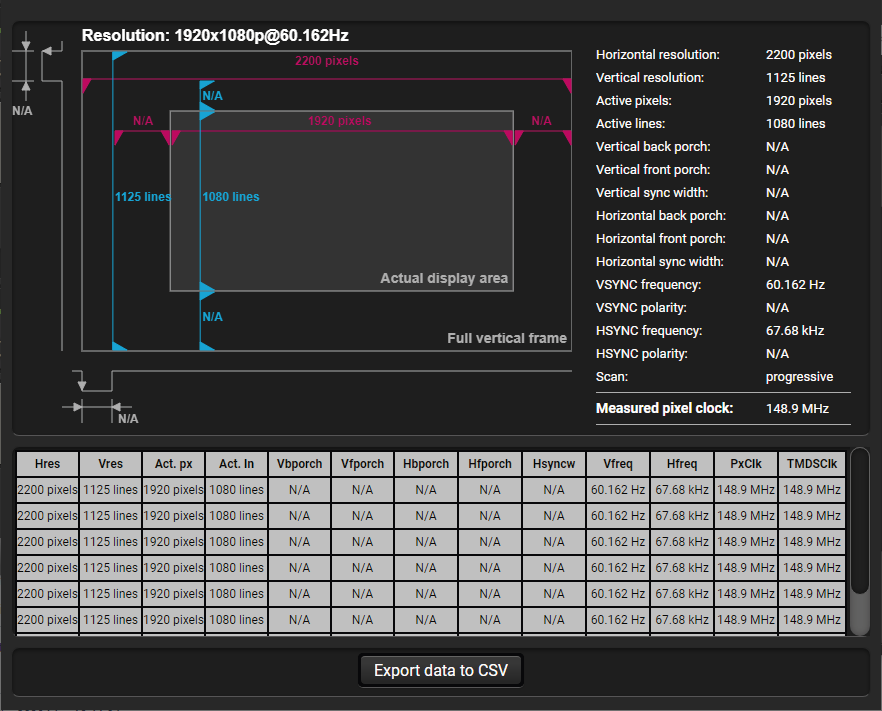
Frame detector window
Lightware’s Frame Detector function works like a signal analyzer, and makes it possible to determine the exact video format that is present on the port, thus helping to identify many problems. E.g. actual timing parameters may differ from the expected, and this may cause some displays to drop the picture.
Frame Detector measures detailed timings on the video signals just like a built-in oscilloscope, but it is much more easy to use. The actual display area shows the active video size (light grey). The dark grey area of the full frame is the blanking interval, which can contain the info frames and embedded audio data for HDMI signals. Shown values are measured directly on the signal and not retrieved only from the HDMI info frames.
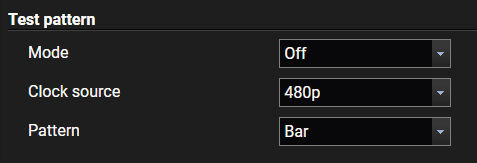
Test pattern options in the port properties window of the optical output
The test pattern feature generates an image that can be displayed when there is no incoming signal on the port. The following settings can be set:
Mode
▪On: the video output port always transmits the test pattern.
▪No signal: the video output port transmits the test pattern if there is no incoming signal on the selected input port.
▪Off: the test pattern function is disabled, the video output port transmits the video signal of the selected input port.
Clock Source
▪480p
▪576p
▪Original video signal
Pattern

▪Red
▪Green
▪Blue
▪Black
▪White
▪Ramp
▪Chess
▪Bar
▪Cycle
#testpattern
Advanced EDID Management can be accessed by selecting the EDID menu. There are two panels: the left one contains Source EDIDs, the right one contains Destination places where the EDIDs can be emulated or copied to. #edid
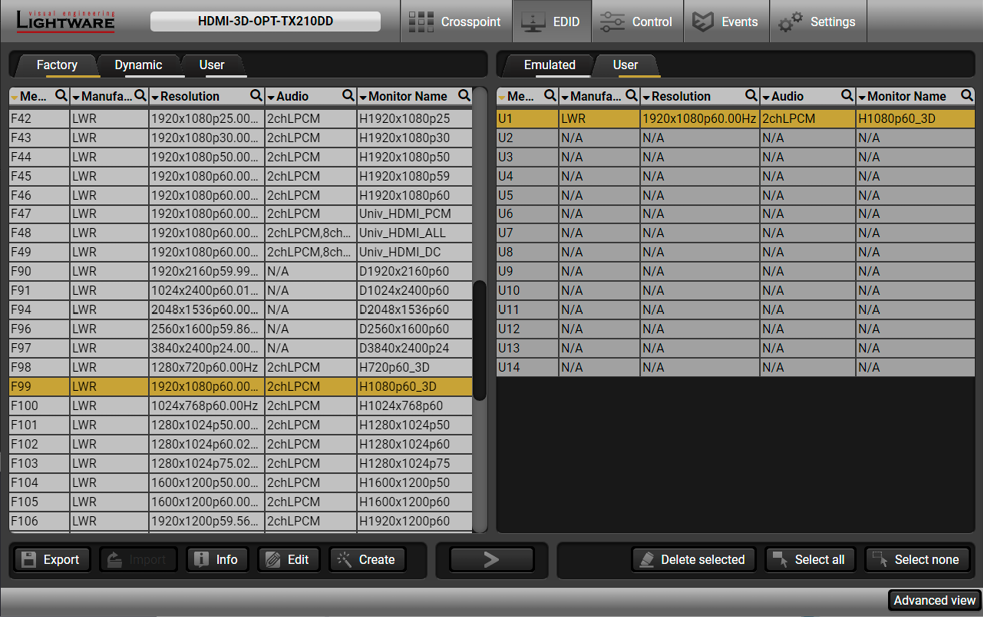
EDID menu
Control Buttons

|
Exporting an EDID (save to a file) |

|
Transfer button: executing EDID emulation or copying |

|
Importing an EDID (load from a file) |

|
Deleting EDID (from User memory) |

|
Display EDID Summary window |

|
Selecting all memory places in the right panel |

|
Opening Advanced EDID Editor with the selected EDID |

|
Selecting none of the memory places in the right panel |

|
Opening Easy EDID Creator |
Changing Emulated EDID

Step 1.Choose the desired EDID list on the source panel and select an EDID.
Step 2.Press the Emulated button on the top of the Destination panel.
Step 3.Select the desired port on the right panel (one or more ports can be selected); the EDID(s) will be highlighted with a yellow background.
Step 4.Press the Transfer button to change the emulated EDID.
Learning an EDID
The process is the same as when changing the emulated EDID; the only difference is the Destination panel: press the User button. This way one or more EDIDs can be copied into the user memory either from the factory memory or from a connected sink (Dynamic).
Exporting an EDID
ATTENTION!ATTENTION! This function works on Windows and macOS operating systems and under Firefox or Chrome web browsers only.

Source EDID can be downloaded as a file (*.bin, *.dat or *.edid) to the computer.
Step 1.Select the desired EDID from the Source panel (line will be highlighted with yellow).
Step 2.Press the Export button to open the dialog box and save the file to the computer.
Importing an EDID

Previously saved EDID (*.bin, *.dat or *.edid file) can be uploaded to the user memory:
Step 1.Press the User button on the top of the Source panel and select a memory slot.
Step 2.Press the Import button below the Source panel.
Step 3.Browse the file in the opening window, then press the Open button. Browsed EDID is imported into the selected User memory.
ATTENTION!ATTENTION! The imported EDID overwrites the selected memory place, even if it is not empty.
Deleting EDID(s)

The EDID(s) from User memory can be deleted as follows:
Step 1.Press User button on the top of the Destination panel.
Step 2.Select the desired memory slot(s); one or more can be selected (“Select All” and “Select None” buttons can be used). The EDID(s) will be highlighted with yellow.
Step 3.Press the Delete selected button to delete the EDID(s).
5.6.2. EDID Summary Window

Select an EDID from the Source panel and press the Info button to display the EDID summary.
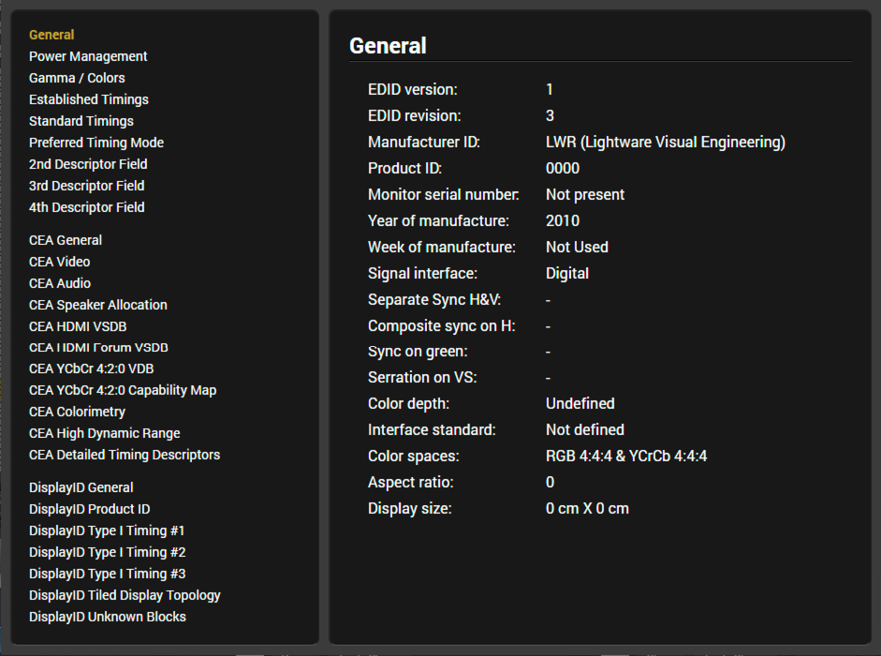
EDID summary window
5.6.3. Editing an EDID

Select an EDID from the Source panel and press the Edit button to display the Advanced EDID Editor window. The editor can read and write all descriptors, which are defined in the standards, including the additional CEA extensions. Any EDID from the device’s memory or a saved EDID file can be loaded into the editor. The software resolves the raw EDID and displays it as readable information to the user. All descriptors can be edited and saved in an EDID file, or uploaded to the User memory. For more details about EDID Editor, please visit our website (www.lightware.com) and download EDID Editor Application Notes.
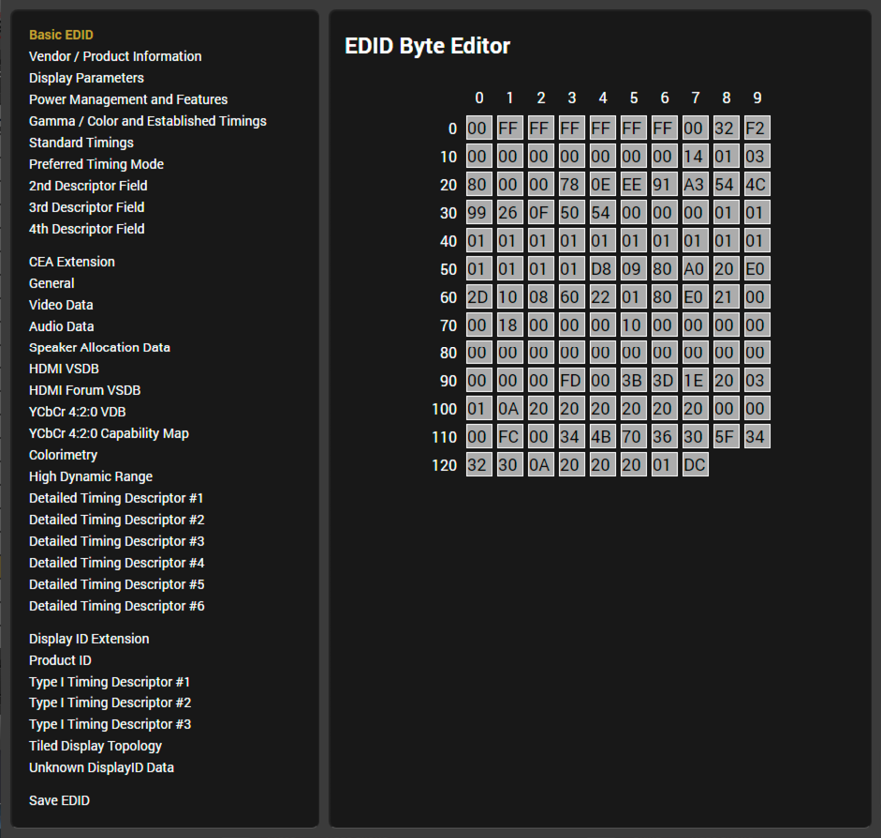
EDID Editor window
5.6.4. Creating an EDID - Easy EDID Creator

Since the above mentioned Advanced EDID Editor needs more complex knowledge about EDID, Lightware introduced a wizard-like interface for fast and easy EDID creation. With Easy EDID Creator, it is possible to create custom EDIDs in four simple steps. By clicking on the Create button below Source panel, Easy EDID Creator is opened in a new window. For more details about EDID Editor, please visit our website (www.lightware.com) and download EDID Editor Application Notes.
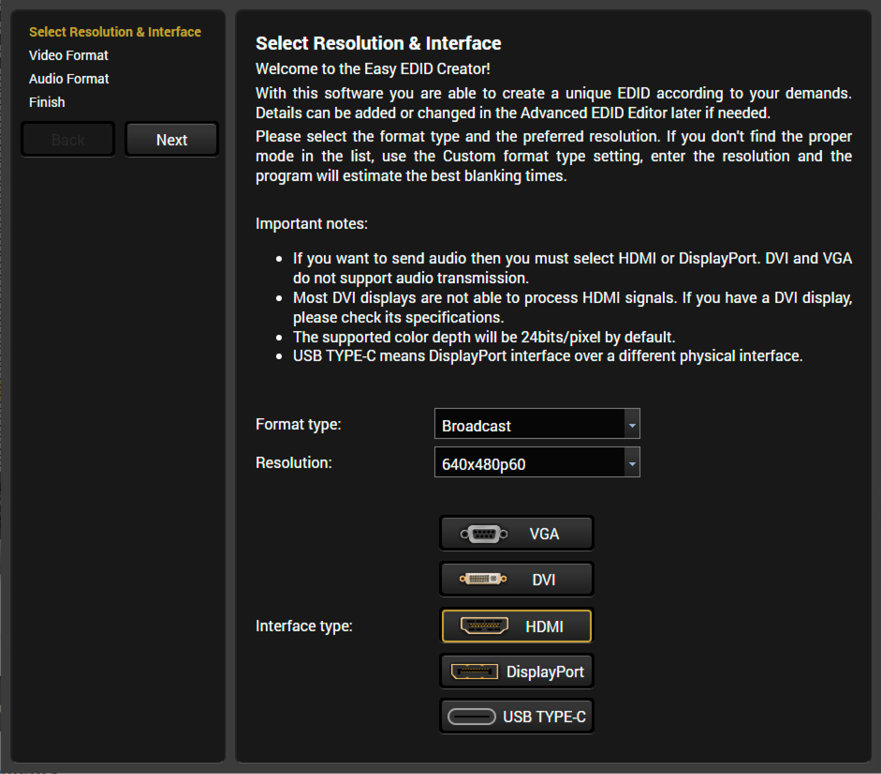
EDID Creator window

RS-232 tab in Control menu
The following settings and functions are available on the local RS-232 port:
▪Baud rate: 4800, 7200, 9600, 14400, 19200, 38400, 57600, 115200;
▪Data bits: 8 or 9;
▪Parity: None, Odd, or Even;
▪Stop bits: 1, 1.5, or 2;
▪Control protocol: LW2 or LW3;
▪Reloading the Factory Default Settings.
#rs232 #rs-232 #serial

The feature means that the device can sense changes on its ports, and is able to react according to the pre-defined settings. The development idea of the Event manager is based on users’ feedbacks. In many cases internal events (such as signal being present or button is pressed) are necessary for display, but it is not easy when the device is hard to access (e.g. built under the desk). For more details and examples about Event Manager, please visit our website (www.lightware.com) and download Event Manager user's guide in the Downloads section.
The Event manager can be configured to perform an action if a condition has been detected. E.g. the desired setup is that after a certain type of audio signal has been detected on the I1 port, the port has to be switched to the O1. The settings can be done via the LDC in the Events menu, or by LW3 protocol commands. The number of the configurable events depends on the device what you are currently using.
Numerous new ideas and requests have been received in connection with the features and settings of the Event manager since the first release. Therefore, the user interface has been re-designed and many new functions have been implemented. The Event editor can be opened by pressing the Edit button at each Event.
There is a grey bar on the left of the Event panel in each line. If a condition and an action are set and the Event is enabled, the bar is displayed in green.

Control menu, Event Manager tab
#eventmanager
5.8.1. The Event Editor
Press the Edit button in the desired Event line to open the Event editor window.

|
|
Event header |
The name of the Event is displayed. Type the desired name and press the Set name button. The Event can be cleared by the Clear button. Use the tick mark to enable/disable the Event. |
|
|
Condition header |
If the condition is set, the description (white colored text) and the exact LW3 protocol expression (yellow colored text) can be seen. If the advanced mode was used, the description is “Custom condition”. |
|
|
Condition panel |
The Wizard, the Advanced or the Link tools are available to set the condition. The parameters and settings are displayed below the buttons. |
|
|
Condition counter |
The set condition can be tested to see the working method in the practice. |
|
|
Delay settings |
The action can be scheduled to follow the condition after the set time value. |
|
|
Action header |
If the action is set, the description (white colored text) and the exact LW3 protocol expression (yellow colored text) can be seen. If the advanced mode was used, the description is “Custom action”. |
|
|
Action panel |
The Wizard, the Advanced or the Link tools are available to set the action. The parameters and settings are displayed below the buttons. |
|
|
Action test |
The set action can be tested to see the working method in the practice. |
5.8.2. Create or Modify an Event
Wizard Mode

The wizard mode lists the most common conditions and actions, so the user does not have to look for LW3 nodes and properties.
Step 1.Click on the Edit button of the desired Event; the Event editor is displayed.
Step 2.The wizard mode is displayed as default. Select the desired Category first (e.g. Audio or Video).
Step 3.Select the desired Expression from the drop-down menu. If any other parameter is necessary to set, it is going to be displayed.
Step 4.Press the Apply button to store the settings of the Condition.
INFO:This mode is also available for setting the Action.
Advanced Mode
The goal of this mode is the same as that of the wizard: set the properties and methods for conditions and actions. The difference is the number of the available and usable properties and methods of the LW3 protocol. Advanced mode allows almost all of it.
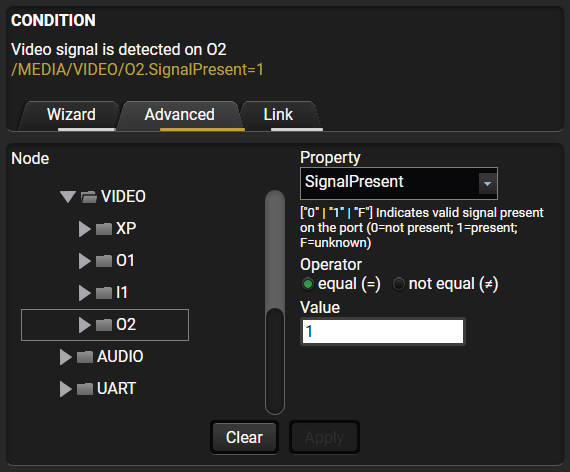
Step 1.Click on the Edit button of the desired Event; the Event editor is displayed.
Step 2.The wizard mode is the default, press the Advanced button. The LW3 protocol tree is displayed, showing the list of the properties in the drop-down menu. Navigate to the desired node.
Step 3.Select the desired Property from the menu. The manual of the property is displayed below to help select the necessary property and to set the value.
Step 4.Set the desired value and operator, then press the Apply button to store settings.
INFO:This mode is also available for setting the Action.
The Link Tool

The new interface allows creating more actions for the same condition. In this case a condition can trigger more actions. To set such an Event, the Link tool has been introduced.
Step 1.Click on the Edit button of the desired Event; the Event editor is displayed.
Step 2.The wizard mode is displayed as default, press the Link button.
Step 3.All the saved Events are analyzed, and the conditions are listed (it takes some seconds to finish). The Show advanced expressions option shows the exact path and set the value of the given property.
Step 4.Select the desired Condition and press the Apply button to store the settings.
INFO:This mode is also available for setting the Action.
5.8.3. Special Tools and Accessories
The Name of the Event
The name of a port can be changed by typing the new name and clicking on the Set button. The following characters are allowed when naming: letters (A-Z) and (a-z), numbers (0-9), special characters: hyphen ( - ), underscore ( _ ), and space ( ).
Enable or Disable an Event
The set Event can be enabled or disabled in the Event list, or directly in the Event editor window by setting the tick mark beside the name.
Testing the Condition
When the desired Condition is arranged, the setting can be tested. The Event list and the Event editor contains a small panel that shows whether the set condition is detected; the Counter can be reset by the button in Event editor. If the Condition is true, the detected mark turns green for two seconds, and the Counter is increased.
Testing the Action
The method is the same as testing the Condition, but in this case the Action can be triggered manually by pressing the Test button.
Delay the Action

In most cases the Action is performed immediately after the Condition is detected. But sometimes a delay is necessary between the Condition and the Action. Therefore, the new Event manager contains the Delay panel, which allows that feature with the settings below:
▪No delay: when the Condition is detected, the Action is launched.
▪Simple delay: when the Condition is detected, the Action is launched after the set time interval.
▪Still true after: when the Condition is detected, the Action is launched after the set time interval only if the Condition still exists.
▪Continuously true: when the Condition is detected, the Action is launched after the set time interval only if the Condition has been existing continuously.
TIPS AND TRICKS:Show advanced expressions option is a useful tool when you look for the path or value of a property, but just the expression is displayed. The option is available in the Event list window, or when Link tool is used.
5.8.4. Clear One or More Event(s)
Clear an Event
Press the Clear button in the Event list or in the header section in the Event editor.
Clear all Events
When all the Events must be cleared, press the Load factory defaults button above the Event list. You will be prompted to confirm the process.
5.8.5. Export and Import Events
The feature allows saving all the Events. The backup file can be uploaded to another HDMI-3D-OPT-TX210DD transmitter.
Export all the Events
Step 1.Press the Export button above the Event list.
Step 2.The Save as dialog box will appear. Set the desired folder and file name, then press the Save button.
The generated file is a simple text file which contains LW3 protocol commands. The file can be viewed by a simple text editor, e.g. Notepad.
ATTENTION!Editing the file is recommended only for expert users.
Import all the Events
Step 1.Press the Import button above the Event list.
Step 2.The Open dialog box will appear. Select the desired folder and file, then press the Open button.
5.9. Settings Menu

Status tab in Settings menu
The most important hardware and software related informations can be found on this tab: hardware and firmware version, serial numbers, temperatures, operation time, and voltage information. Device label can be changed to unique description by the Set button. #status #lockbutton #button #controllock #label #devicelabel #producttype #serialnumber
Button Lock
The operation of the front panel buttons can be locked. The setting can be disabled only by the LCD software or by an LW3 protocol command (see the details in the Lock the Front Panel Buttons section).
5.9.2. Backup
Details about this function can be found in the Configuration Cloning (Backup Tab) section.

System tab in Settings menu
Three functions are available under System tab:
▪Download system log - saving the file of the device.
▪Load factory defaults - recalling factory defaults settings and values. All factory default settings are listed in the Factory Default Settings section.
▪Reboot - rebooting the system.
#systemlog #log #factory #reboot #restart #reset
5.10. Configuration Cloning (Backup Tab)
Configuration cloning of Lightware LW3 devices is a simple method that eliminates the need to repeatedly configure certain devices to have identical (non-factory) settings. If the devices are installed in the same type of system multiple times, then it is enough to set up only one device to fit the user’s needs and then copy those settings to the others, thus saving time and resources. #backup #configurationcloning

Backup tab in the Settings menu
5.10.1. Steps in a Nutshell
Installing multiple devices with the same customized configuration settings can be done in a few easy steps:
Step 1.Configure one device with all your desired settings using the LDC software.
Step 2.Backup the full configuration file to your computer.
Step 3.If needed, make some modifications to the configuration file using a text editor (e.g. Notepad).
Step 4.Connect to the other device that has to be configured and upload (restore) your configuration file.
Step 5.Done! You can have as many totally identical, customized devices as you like.
5.10.2. Save the Settings of a Device (Backup)
Step 1.Apply the desired settings in the transmitter (port parameters, crosspoint, etc.)
Step 2.Select the Settings / Backup tab from the menu.
Step 3.Write a short description in the text box on the left (optional).
Step 4.Press the Create a full backup button. You will be prompted to save the file to the computer. The default file name is the following:
|
BACKUP_<DEVICE TYPE>_SN<SERIAL NUMBER>.LW3 |
Step 5.Set the desired file name, select the folder and save the file.
TIPS AND TRICKS:Using the exact product type in the filename is recommended, since it makes the file usage more comfortable.
About the Backup File
The backup file is a simple text file that contains LW3 protocol commands. The first line is the description and the further lines are the commands which will be executed during the restore process. The file can be viewed (and/or edited) by a simple text editor, e.g. Notepad.
See the entire list of saved data in the section.
ATTENTION!Editing the command lines is only recommended for expert users.
5.10.3. Upload the Settings to a Device (Restore)
WARNING!Please note that the settings will be permanently overwritten with the restored parameters in the device. Withdrawal is not possible.
ATTENTION!The cloning can be successful if the backup file is downloaded from the same type of source device as the destination device.
The Restoring Process
Step 1.Select the Settings / Backup tab from the menu.
Step 2.Click on the Choose file button on the right panel and browse the desired file.
Step 3.The file is checked and the result will be displayed in the textbox below. If the file is correct, the settings can be restored.
Step 4.Press the Start restore process button and click on the Yes button when asked.
Step 5.Reboot the device to apply the network settings after finishing.
5.11. Advanced View (Terminal Window)

|
|
LW3 protocol help |
Pushing the button results a help window opening which describes the most important informations about LW3 protocol commands in HTML format. |
|
|
|
Edit mode |
The default appearance is the read-only mode. If you want to modify the values or parameters, tick the option. You will be prompted to confirm your selection. #terminal #advancedview |
|
|
|
Warning mode |
If this is checked, a warning window pops up when you enable Edit mode. |
|
|
|
Node list |
Correspondent parameters and nodes are shown which are connected to the selected item in the protocol tree. The commands typed in these fields are escaped automatically |
|
|
Manual button: |
Manual (short description) of the node can be called and displayed in the terminal window. |
||
|
Set button: |
Saves the value/parameter typed in the textbox. |
||
|
Call button: |
Calls the method, e.g. reloads factory default settings. |
||
|
|
Protocol tree |
LW3 protocol tree; select an item to see its content. |
|
|
|
Command line |
The commands typed in this line are not escaped automatically. See more information in the Escaping section. |
|
|
|
Terminal window |
Commands and responses with time and date are listed in this window. Sent command starts with ‘>’ character, received response starts with ‘<’ character. The color of each item depends on the type of the command and response. The content of the window can be emptied by the Clear button. If the Autoscroll option is ticked, the list is scrolled automatically when a new line is added. |
|
The device can be controlled through a reduced command set of LW2 protocol commands to ensure the compatibility with other Lightware products. The supported LW2 commands are described in this chapter.
6.1. LW2 Protocol Description
The protocol description hereinafter stands for Lightware protocol. The commands can be sent to the device in RAW format via the TCP/IP port no. 10001.
The receiver accepts commands surrounded by curly brackets - { } - and responds with data surrounded by round brackets - ( ) - only if a command was successfully executed. All input commands are converted to uppercase, but respond commands can contain upper and lower case letters as well.
Legend for Control Commands
|
Format |
Explanation |
|
<in> |
Input number in 1 or 2 digit ASCII format (01, 5, 07, 16, etc.) |
|
<out> |
Output number in 1 or 2 digit ASCII format |
|
<in/out> |
input or output port number in 1 or 2 digit ASCII format * |
|
<in2> |
Input number in 2 digit ASCII format (01, 02, 10, 12 etc.) |
|
<out2> |
Output number in 2 digit ASCII format (01, 02, 10, 12 etc.) |
|
<in2/out2> |
input or output number in 2 digit ASCII format* |
|
<loc> |
Location number in 1, 2 or 3 digit ASCII format |
|
<id> |
id number in 1 or 2 digit ASCII format |
|
<id2> |
id number in 2 digit ASCII format |
|
CrLf |
Carriage return, Line feed (0x0D, 0x0A) |
|
· |
Space character (0x20) |
|
→ |
Each command issued by the controller |
|
← |
Each response received from the router |
* The command has the same arguments on the input ports and the output port, as well.
6.2. Instructions for the Terminal Application Usage
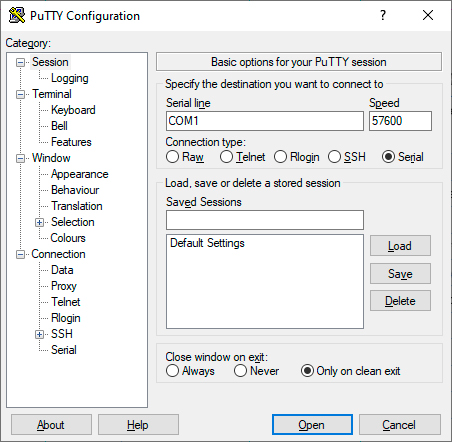
Terminal Application
The LW2 protocol commands can be applied to the transmitter using a terminal application. You need to install one of them to your control device, for example Putty or CLI. #terminal
Establishing Connection
Follow the steps for establishing connection to the device:
Step 1.Connect the transmitter to the controller device over RS-232.
Step 2.Open the terminal application (e.g. Putty).
Step 3.Add the Serial line of the device and the Speed (default: 57600).
Step 4.Select the Serial connection type, and open the connection.
ATTENTION!Make sure that the control protocol is set to LW2 on the serial port. The protocol setting can be checked in LDC (see the details in the RS-232 section) and via LW3 protocol command (see the details in the Protocol Setting section).
Once the terminal window is opened, you can enter the LW2 protocol commands, which are listed in the following sections.
6.3. General LW2 Commands
6.3.1. List of All Available LW2 Commands
Command and Response
»{lcmd}
«(LCMD# LCMD: List all commands)CrLf
«<LW2_commands>CrLf
«(LCMD END)CrLf
Example
»{lcmd}
«(LCMD# LCMD: List all commands)
«(LCMD# PING: Always response PONG)
«(LCMD# CT: Compile time)
«...
«(LCMD END)
INFO:The response is longer, not all the lines can be seen in the example.
6.3.2. View Product Type
The device responds with its name.
Command and Response #producttype
»{i}
«(I:<PRODUCT_TYPE>)CrLf
Example
»{i}
«(I:HDMI-3D-OPT-TX210DD)
6.3.3. Device Label Query
This command is for querying the label of the device, which can be changed in the Status menu in LDC or by LW3 command, see the Set the Device Label section.
Command and Response #label #devicelabel
»{label}
«(LABEL=<device_label>)CrLf
Example
»{label}
«(LABEL=TX210DD_ConferenceRoom)
This command queries the active protocol of the currently used control interface.
Command and Response #protocol
»{P_?}
«(CURRENT·PROTOCOL·=·#<protocol>)CrLf
Example
»{p_?}
«(CURRENT PROTOCOL = #1)
'#1' means the device communicates with LW2 protocol.
6.3.5. View Firmware Version of the CPU
Command and Response #firmwareversion
»{F}
«(FW:<FW_VER><s>)CrLf
Example
»{f}
«(FW:1.6.0b13 r99)
<FW_VER> is the firmware version. It is followed by <s> string which may indicate special versions.
Returns the date of when the CPU firmware was compiled.
Command and Response
»{CT}
«(Complied: <DATE&TIME>)CrLf
Example
»{ct}
«(Compiled: Sep 30 2021 14:07:56)
The device responds with its 8-digit serial number.
Command and Response #serialnumber
»{S}
«(SN:<SERIAL_N>)CrLf
Example
»{s}
«(SN:5A004254)
The serial number structure can be found in the About the Serial Number section.
Shows the hardware name and the revision of the installed boards.
Command and Response
»{IS}
«(SL#·0·<MB_DESC>)CrLf
«(SL·END)CrLf
Example
»{is}
«(SL# 0 HDMI-3D-OPT-TX210DD)
«(SL END)
The device reports its motherboard (slot 0).
6.3.9. View Firmware for All Controllers
Shows the firmware versions of all installed controllers.
Command and Response
»{FC}
«(CF·<DESC>)CrLf
«(CF·<DESC>)CrLf
«…
«(CF END)CrLf
Example
»{fc}
«(CF HDMI-3D-OPT-TX210DD 1.2.0b1 r53)
«(CF END)
The device has one control panel.
Internal voltages and measured temperature values are shown.
Command and Response #status
»{ST}
«(ST·<DESC>)CrLf
Example
»{st}
«(ST CPU 12.16V 5.03V 3.30V 3.33V 3.37V 1.30V 1.86V 1.00V 53.22C 53.26C)
6.3.11. Restart the Device
The device can be restarted without unplugging power.
Command and Response #reboot #restart #reset
»{RST}
«
Example
»{rst}
«
The device reboots; no response is sent in this case.
6.3.12. Restore Factory Default Settings
Settings can be reset to factory default values as follows: #factory
Command and Response
»{FACTORY=ALL}
«(FACTORY ALL…)CrLf
Example
»{factory=all}
«(FACTORY ALL…).
All settings and parameters are reset to factory default, see the table in the Factory Default Settings section.
6.4. AV Port Settings
Mute the <out> output. The output signal is turned off.
Command and Response #mute #lock #unmute #unlock
»{#<out>•<layer>}
«(1MT<out2>•<layer>)CrLf
Parameters
|
Parameter |
Parameter description |
Value |
Parameter value |
|
<layer> |
Signal type of the layer |
A |
audio layer |
|
V |
video layer |
||
|
AV |
audio & video layer |
||
|
<out> |
Output port |
O1 |
HDMI out |
|
<in> |
Input port |
I1 |
HDMI in |
INFO:The <layer> parameter can usually be skipped for legacy purposes. In this case, the devices change all (Video & Audio) layers, but when using status commands, it only displays information about the Video layer. Please use the AV option when available.
Example
»{#01 A}
«(1MT01 A)
ATTENTION!Muting does not change the state of the crosspoint, but disables the output itself. This way the last connection can be easily restored with an unmute command. Switching a muted output does not unmute the output.
Unmute the <out> output.
Command and Response
»{+<out>•<layer>}
«(0MT<out2>•<layer>)CrLf
Example
»{+01 V}
«(0MT01 V)
INFO:Unmuting an output makes the previous connection active, as the crosspoint state has not been changed by the muting command, only the output was disabled.
Locking an output port. Output’s state cannot be changed until unlocking.
Command and Response
»{#><out>•<layer>}
«(1LO<out²>•<layer>)CrLf
Example
»{#>01 A}
«(1LO01 A)
Unlocking an output port. The connection on output can be changed.
Command and Response
»{+<<out>•<layer>}
«(0LO<out2>•<layer>)CrLf
Example
»{+<01 V}
«(0LO01 V)
O1 video output port is unlocked.
INFO:The device issues the response seen above regardless of the previous state of the output (either it was locked or unlocked).
6.4.5. View Connection State on the Output
Viewing the crosspoint state of the device; showing the input port numbers connected to the outputs.
Command and Response #crosspoint #switch
»{VC•<layer>}
«(ALL<layer>•<O01>•<O02>)CrLf
Parameters
O01 shows the corresponding output’s connection state.
|
Parameter |
Parameter description |
Value |
Parameter value |
|
<layer> |
Signal type of the layer |
A |
audio layer |
|
V |
video layer |
||
|
AV |
audio & video layer |
State letters
|
Letter |
State |
Example |
|
L |
Output is locked |
L01 |
|
M |
Output is muted |
M01 |
|
U |
Output is locked and muted |
U01 |
Example
»{VC V}
«(ALLV 01)
«(ALLA 01 02)
I1 video input port is connected to the O1 (optical out) and O2 (local HDMI out) video output ports.
Shows the physical crosspoint size.
Command and Response
»{getsize•<layer>}
«(SIZE=<size>•<layer>)CrLf
Parameters
|
Parameter |
Parameter description |
Value |
Parameter value |
|
<size> |
Crosspoint size |
<number_of_inputs>x<number_of _outputs> |
|
|
<layer> |
Signal type of the layer |
A |
audio layer |
|
V |
video layer |
||
|
AV |
audio & video layer |
||
Example
»{GETSIZE AV}
«(SIZE=1x2 V)
«(SIZE=3x2 A)
The device has a video crosspoint (1 input and 2 outputs) and an audio crosspoint (3 inputs and 2 outputs).
6.4.7. Change the Audio Autoselect Mode
The autoselect mode of the audio output can be changed.
Command and Response #autoselect
»{AS_A<out>=<state>;<mode>}
«(AS_A<out>=<state>;<mode>)CrLf
Parameters
|
Parameter |
Parameter description |
Value |
Value description |
|
<state> |
Showing the Autoselect state |
E |
autoselect is enabled |
|
D |
autoselect is disabled |
||
|
<mode> |
The autoselect mode setting |
F |
First detect mode |
|
L |
Last detect mode |
||
|
P |
Priority detect mode |
Example
»{as_a1=E;P}
«(AS_A1=E;P)
The Autoselect mode of audio output1 is enabled and is set to Priority mode.
INFO:The Autoselect mode can be queried by typing the {as_a<out>=?} command.
6.4.8. Change the Audio Input Priorities
The settings of audio input priority can be changed as follows.
Command and Response
»{PRIO_A<out>=<in1_prio>;<in2_prio>;…;<inn_prio>}
«(PRIO_A<out>=<in1_prio>;<in2_prio>;…;<inn_prio>)CrLf
Parameters
|
Parameter |
Parameter description |
Value |
Value description |
|
<in1_prio> <in2_prio> <inn_prio> |
Priority number of the input ports |
0-2, 31 |
0: highest priority 2: lowest priority 31: skip the port from the priority list |
Example
»{prio_a1=1;0;2}
«(PRIO_A1=1;0;2)
Input 2 has the highest priority (0), Input 1 has the second highest (1). Input 3 has the lowest priority (2).
ATTENTION!Always set the priority for all the ports during the change, otherwise the change will not be executed and the response will be the current setting (like querying the priority setting).
INFO:The audio priorities can be queried by typing the {prio_a<out>=?} command.
6.5.1. RS-232 Parameters Settings
Command and Response #serial #rs232 #rs-232
»{RS232_LOCAL_FORMAT=<BaudRate>;<DataBit>;<Parity>;<StopBit>}
«(RS232_LOCAL_FORMAT=<BaudRate>;<DataBit>;<Parity>;<StopBit>)CrLf
Parameters
|
Parameter |
Parameter description |
Value |
Parameter value |
|
<BaudRate> |
Baud rate |
X |
No change |
|
4800 |
4800 |
||
|
7200 |
7200 |
||
|
9600 |
9600 |
||
|
14400 |
14400 |
||
|
19200 |
19200 |
||
|
38400 |
38400 |
||
|
57600 |
57600 |
||
|
115200 |
115200 |
||
|
<DataBit> |
Data bit |
X |
No change |
|
8 |
8 |
||
|
9 |
9 |
||
|
<Parity> |
Parity |
X |
No change |
|
N |
None |
||
|
E |
Even |
||
|
O |
Odd |
||
|
<StopBit> |
Stop Bit |
X |
No change |
|
1 |
1 |
||
|
1,5 |
1,5 |
||
|
2 |
2 |
Example
»{rs232_local_format=9600;8;O;X}
«(RS232_LOCAL_FORMAT=9600;8;O;X)
Explanation
RS -232 port is set as the following: the baud rate to 9600, data bit to 8, parity to odd, and stop bit is not changed, it remained 1.
INFO:The actual RS-232 parameters can be queried by the {RS232_LOCAL_FORMAT=?} command.
6.5.2. RS-232 Control Protocol Port Setting
The control protocol of local RS -232 port can be set as follows.
Command and Response #protocol
»{RS232_LOCAL_PROT=<protocol>}
«(RS232_LOCAL_PROT=<protocol>)CrLf
Parameters
|
Parameter |
Parameter description |
Value |
Parameter value |
|
<protocol> |
RS-232 control protocol |
LW2 |
LW2 control protocol |
|
LW3 |
LW3 control protocol |
Example
»{rs232_local_prot=lw2}
«(RS232_LOCAL_PROT=LW2)
INFO:The actual RS-232 parameters can be queried by the {RS232_LOCAL_PROT=?} command.
6.6. LW2 Commands – Quick Summary
The device can be controlled through Lightware 3 (LW3) protocol commands to ensure the compatibility with other Lightware products. The supported LW3 commands are described in this chapter.
7.1. Overview
The Lightware Protocol #3 (LW3) is implemented in almost all new Lightware devices (matrix switchers, signal extenders and distribution amplifiers) since 2012. The protocol is ASCII-based, and all commands are terminated with a carriage return (Cr, ‘\r’) and line feed (Lf, ‘\n’) pair. It is organized as a tree structure that provides outstanding flexibility and user-friendly handling with ‘nodes’, ‘properties’ and ‘methods’. The Advanced View of the Lightware Device Controller software is the perfect tool for browsing and learning how the LW3 protocol can be used in practice.
7.2. Instructions for the Terminal Application Usage

Terminal Application
The LW3 protocol commands can be applied to the transmitter using a terminal application. You need to install one of them to your control device, for example Putty or CLI. #terminal
Establishing Connection
Follow the steps for establishing connection to the device:
Step 1.Connect the transmitter to the controller device over RS-232.
Step 2.Open the terminal application (e.g. Putty).
Step 3.Add the Serial line of the device and the Speed (default: 57600).
Step 4.Select the Serial connection type, and open the connection.
ATTENTION!Make sure that the control protocol is set to LW3 on the serial port. The protocol setting can be checked in LDC (see the details in the RS-232 section) and via LW2 protocol command (see the details in the RS-232 Control Protocol Port Setting section).
Once the terminal window is opened, you can enter the LW3 protocol commands, which are listed in the following sections.
7.3. Protocol Rules
7.3.1. LW3 Tree Structure and Command Structure (examples)

7.3.2. General Rules
▪All names and parameters are case-sensitive.
▪The nodes are separated by a slash (‘/’) character.
▪The node name can contain the elements of the English alphabet and numbers.
▪The command lines have to be closed by Carriage return and Line Feed (CrLf).
▪Use the TCP port no. 6107 when using LW3 protocol over Ethernet.
▪The length of a line (command/response, command type / prefix, path, method/property and parameters together) can be max. 800 bytes.
▪When a command is issued by the device, the received response cannot be processed by the CPU.
▪The node paths describe the exact location of the node, listing each parent node up to the root.
7.3.3. Legend for the Control Commands
Command and Response – Example
»GET·/MEDIA/VIDEO/I2.SignalPresent
«pr·/MEDIA/VIDEO/I2.SignalPresent=<signal_present>
|
Format |
Description |
|
<in> |
Input port number |
|
<out> |
Output port number |
|
<port> |
Input or output port number |
|
<loc> |
Location number |
|
<parameter> |
Specific property defined and described in the command |
|
<expression> |
Batched parameters: the underline means that more expressions or parameters can be placed by using a semicolon, e.g. I1;I3 or F27:E1;F47:E2 |
|
» |
Sent command |
|
« |
Received response |
|
· |
Space character |
Further, not listed <parameters> are defined at each command.
7.3.4. Command Types
The GET command can be used to get the child nodes, properties and methods of a specific node. It can also be used to get the value of a property. Use the dot character (.) when addressing a property:
»GET /.SerialNumber
«pr /.SerialNumber=87654321
GETALL command
The GETALL command can be used to get all child nodes, properties and methods of a node with one command.
»GETALL /MEDIA/UART
«ns /MEDIA/UART/P1
«pr /MEDIA/UART.PortCount=1
«pr /MEDIA/UART.PortUi=P1:12209
«pr /MEDIA/UART.P1=RS-232
SET command
The SET command can be used to modify the value of a property. Use the dot character (.) when addressing the property:
»SET /MEDIA/VIDEO/I1.ColorSpaceMode=0
«pw /MEDIA/VIDEO/I1.ColorSpaceMode=0
CALL command
A method can be invoked by the CALL command. Use the colon character (:) when addressing the method:
»CALL /MEDIA/VIDEO/XP:unlock(I1)
«mO /MEDIA/VIDEO/XP:unlock
MAN command
The manual is a human readable text that describes the syntax and provides a hint for how to use the primitives. For every node, property and method in the tree there is a manual; type the MAN command to get the manual:
»MAN /MEDIA/VIDEO/O1.Pwr5vMode
«pm /MEDIA/VIDEO/O1.Pwr5vMode ["0" | "1" | "2"] 0 - Auto, 1 - Always On, 2 - Always Off
7.3.5. Prefix Summary
DEFINITION:The prefix is a 2-character-long code that describes the type of the response.
The following prefixes are defined in the LW3 protocol:
|
Prefix |
Description |
Prefix |
Description |
|
|
n- |
a node |
pm |
a manual for the property |
|
|
nE |
an error for a node |
m- |
a method |
|
|
nm |
a manual for a node |
mO |
a response after a successful method execution |
|
|
pr |
a read-only property |
mF |
a response after a failed method execution |
|
|
pw |
read-write property |
mE |
an error for a method |
|
|
pE |
an error for the property |
mm |
a manual for a method |
7.3.6. Error Messages
There are several error messages defined in the LW3 protocol, all of them have a unique error number.
»CALL /MEDIA/VIDEO/XP:switch(IA:O1)
«mE /MEDIA/VIDEO/XP:switch %E004:Invalid value
DEFINITION:An escape sequence is a sequence of characters that does not represent itself when used inside a character or string literal, but is translated into another character or a sequence of characters.
Property values and method parameters can contain characters that are used as control characters in the protocol. They must be escaped. The escape character is the backslash (‘\’) and escaping means injecting a backslash before the character that should be escaped (like in C language).
Control characters are the following: \ { } # % ( ) \r \n \t
The original message: CALL /MEDIA/UART/P1:sendMessage(Set(01))
The escaped message: CALL /MEDIA/UART/P1:sendMessage(Set\(01\))
7.3.8. Signature
DEFINITION:The signature is a four-digit-long hexadecimal value that can be optionally placed before every command to keep a command and the corresponding responses together as a group.
Each line is terminated with carriage return (Cr, ‘\r’) and line feed (Lf, ‘\n’) characters. In several cases the number of the lines in the response cannot be determined in advance, e.g. the client intends to receive the whole response and also wants to be sure that the received lines belong together and to the same command. In these cases a special feature, the ‘signature’ can be used. The response to that particular command will also be preceded by the signature, and the corresponding lines will be between brackets:
»1700#GET /EDID.*
«{1700
«pr /EDID.EdidStatus=F89:E1;D1:E2;D1:E3;D1:E4;F89:E5
«m- /EDID:copy
«m- /EDID:delete
«m- /EDID:reset
«m- /EDID:switch
«m- /EDID:switchAll
«}
INFO:The lines of the signature are also Cr and Lf terminated.
DEFINITION:Subscription to a node means that the user will get a notification if a property of the node changes.
A user can subscribe to any node. These notifications are asynchronous messages, and are useful to keep the client application up to date without having to periodically poll the node to detect a changed property. When the user does not want to be informed about the changes anymore, he can simply unsubscribe from the node.
ATTENTION!The subscriptions are handled separately for connections. Hence, if the connection is terminated, all registered subscriptions are deleted. After reopening a connection, all subscribe commands have to be sent in order to get the notifications of the changes on that connection.
Subscribe to a Node
»OPEN /MEDIA/VIDEO
«o- /MEDIA/VIDEO
Subscribe to Multiple Nodes
»OPEN /MEDIA/VIDEO/*
«o- /MEDIA/VIDEO/*
Unsubscribe from a Node
»CLOSE /MEDIA/VIDEO
«c- /MEDIA/VIDEO
Get the Active Subscriptions
»OPEN
«o- /MEDIA/VIDEO
«o- /EDID
«o- /DISCOVERY
Unsubscribe from Multiple Nodes
»CLOSE /MEDIA/VIDEO/*
«c- /MEDIA/VIDEO/*
7.3.10. Notifications about the Changes of the Properties
When the value of a property is changed, and the user is subscribed to the node that the property belongs to, an asynchronous notification is generated. This notification is called the ‘change message’. The format of such a message is very similar to the response for the GET command:
«CHG /EDID.EdidStatus=F48:E1
A Short Example of How to Use the Subscription
There are two independent users controlling the device through two independent connections (Connection #1 and Connection #2). The events in the rows occur after each other.
|
»OPEN /MEDIA/AUDIO/O3 «o- /MEDIA/AUDIO/O3 »GET /MEDIA/AUDIO/O3.VolumePercent «pw /MEDIA/AUDIO/O3.VolumePercent=100.00 |
connection #1 |
|
»GET /MEDIA/AUDIO/O3.VolumePercent «pw /MEDIA/AUDIO/O3.VolumePercent=100.00 »SET /MEDIA/AUDIO/O3.VolumePercent=50.00 «pw /MEDIA/AUDIO/O3.VolumePercent=50.00 |
connection #2 |
|
«CHG /MEDIA/AUDIO/O3.VolumePercent=50.00 |
connection #1 |
The first user (Connection #1) set a subscription to a node. Later the other user (Connection #2) made a change, and thanks to the subscription, the first user got a notification about the change.
7.4. System Commands
The name of the product is a read-only parameter and cannot be modified.
Command and Response #producttype
»GET·/.ProductName
«pr·/.ProductName=<product_name>
Example
»GET /.ProductName
«pr /.ProductName=HDMI-3D-OPT-TX210DD
ATTENTION!The device label can be changed to a custom text in the Status tab of the LDC software. This writable parameter is not the same as the ProductName parameter. #devicelabel #label
The default format of the device label is: LW_<product_name>_<serial_no>
Command and Response
»SET·/MANAGEMENT/UID.DeviceLabel=<Custom_name>
«pw·/MANAGEMENT/UID.DeviceLabel=<Custom_name>
The Device Label can be 39 characters long and ASCII characters are allowed. Longer names are truncated.
Example
»SET /MANAGEMENT/UID.DeviceLabel=TX210DD_Control_room
«pw /MANAGEMENT/UID.DeviceLabel=TX210DD_Control_room
7.4.3. Query the Serial Number
Command and Response #serialnumber
»GET·/.SerialNumber
«pr·/.SerialNumber=<serial_nr>
Example
»GET /.SerialNumber
«pr /.SerialNumber=87654321
7.4.4. Query the Firmware Version
Command and Response #firmwareversion
»GET·/SYS/MB.FirmwareVersion
«pr·/SYS/MB.FirmwareVersion=<firmware_version>
Example
»GET /SYS/MB.FirmwareVersion
«pr /SYS/MB.FirmwareVersion=1.2.0b1 r43
The devices can be restarted – the current connections (USB, RS-232) will be terminated.
Command and Response #reboot #reset #restart
»CALL·/SYS:reset()
«mO·/SYS:reset=
Example
»CALL /SYS:reset()
«mO /SYS:reset=
7.4.6. Restore the Factory Default Settings
Command and Response #factory
»CALL·/SYS:factoryDefaults()
«mO·/SYS:factoryDefaults=
Example
»CALL /SYS:factoryDefaults()
«mO /SYS:factoryDefaults=
The device is restarted, current connections are terminated, and the default settings are restored. See the complete list in the Factory Default Settings section.
7.4.7. Lock the Front Panel Buttons
Command and Response #frontpanel #controllock #button
»SET /MANAGEMENT/UI.ControlLock=<lock_status>
«pw /MANAGEMENT/UI.ControlLock=<lock_status>
Parameters
|
Identifier |
Parameter description |
Value |
Explanation |
|
<lock_status> |
Control lock status of the front panel buttons |
1 |
None - All functions of the front panel buttons are enabled. |
|
2 |
Locked - The front panel buttons are locked and they can be unlocked by pressing the Audio select and the Show me buttons, or with an LW3 protocol command. |
||
|
3 |
Force locked - Locking and unlocking of the front panel buttons are possible only via protocol command. |
Example
»SET /MANAGEMENT/UI.ControlLock=1
«pw /MANAGEMENT/UI.ControlLock=1
7.5. Video Port Settings
INFO:Video port numbering can be found in the Port Numbering section. #status #portstatus
7.5.1. Query the Status of Source Ports
Command and Response
»GET·/MEDIA/VIDEO/XP.SourcePortStatus
«pr·/MEDIA/VIDEO/XP.SourcePortStatus=<in1_state>;<in2_state>;<…>; <in#_state>
The response contains 5 ASCII characters for each port. The first character indicates the mute/lock state, the next four characters represent a 2-byte HEX code showing the current state of the input ports.
Example
»GET /MEDIA/VIDEO/XP.SourcePortStatus
«pr /MEDIA/VIDEO/XP.SourcePortStatus=T00AF
Parameters

|
Letter (Character 1) |
||
|
Mute state |
Lock state |
|
|
T |
Unmuted |
Unlocked |
|
L |
Unmuted |
Locked |
|
M |
Muted |
Unlocked |
|
U |
Muted |
Locked |
|
Byte 1 |
Byte 2 |
|||||||
|
Character 2 |
Character 3 |
Character 4 |
Character 5 |
|||||
|
BIT 7-6 |
BIT 5-4 |
BIT 3-2 |
BIT 1-0 |
BIT 7-6 |
BIT 5-4 |
BIT 3-2 |
BIT 1-0 |
|
|
Reserved |
Reserved |
Reserved |
Reserved |
Embedded audio status |
Reserved |
Signal present status |
Connection status |
|
|
0 0 |
Reserved |
Reserved |
Reserved |
Reserved |
Unknown |
|||
|
0 1 |
Reserved |
|||||||
|
1 0 |
No embedded audio |
Reserved |
No signal |
Not connected |
||||
|
1 1 |
Embedded audio presents |
Signal presents |
Connected |
|||||
The Most Common Received Port Status Responses
|
T00AA |
T |
0 |
0 |
A |
A |
||||
|
Unlocked, Unmuted |
0 0 |
0 0 |
0 0 |
0 0 |
1 0 |
1 0 |
1 0 |
1 0 |
|
|
Reserved |
Reserved |
Reserved |
Reserved |
No embedded audio |
Not encrypted |
No signal |
Not connected |
||
|
T00AB |
T |
0 |
0 |
A |
B |
||||
|
Unlocked, Unmuted |
0 0 |
0 0 |
0 0 |
0 0 |
1 0 |
1 0 |
1 0 |
1 1 |
|
|
Reserved |
Reserved |
Reserved |
Reserved |
No embedded audio |
Not encrypted |
No signal |
Connected |
||
|
T00AF |
T |
0 |
0 |
A |
F |
||||
|
Unlocked, Unmuted |
0 0 |
0 0 |
0 0 |
0 0 |
1 0 |
1 0 |
1 1 |
1 1 |
|
|
Reserved |
Reserved |
Reserved |
Reserved |
No embedded audio |
Not encrypted |
Signal presents |
Connected |
||
|
T00EF |
T |
0 |
0 |
E |
F |
||||
|
Unlocked, Unmuted |
0 0 |
0 0 |
0 0 |
0 0 |
1 1 |
1 0 |
1 1 |
1 1 |
|
|
Reserved |
Reserved |
Reserved |
Reserved |
Embedded audio presents |
Not encrypted |
Signal presents |
Connected |
||
7.5.2. Query the Status of Destination Port
Command and Response #status #portstatus
»GET·/MEDIA/VIDEO/XP.DestinationPortStatus
«pr·/MEDIA/VIDEO/XP.DestinationPortStatus=<out1_state>;<out2_state>;<…>;<out#_state>
Parameters
<out#_state> The response contains 5 ASCII characters for each port. The first character indicates the mute/lock state, the next 2-byte long HEX code showing the current state of the output port.
Example
»GET /MEDIA/VIDEO/XP.DestinationPortStatus
«pr /MEDIA/VIDEO/XP.DestinationPortStatus=M00BF;T00FF
Legend
See at the previous section.
Example and Explanation
|
M |
0 |
0 |
B |
F |
||||
|
Unlocked, Muted |
0 0 |
0 0 |
0 0 |
0 0 |
1 0 |
1 1 |
1 1 |
1 1 |
|
Reserved |
Reserved |
Reserved |
Reserved |
No embedded audio |
Encrypted |
Signal presents |
Connected |
|
7.5.3. Query the Video Crosspoint Setting
Command and Response
»GET·/MEDIA/VIDEO/XP.DestinationConnectionList
«pr·/MEDIA/VIDEO/XP.DestinationConnectionList=<in>
Example
»GET /MEDIA/VIDEO/XP.DestinationConnectionList
«pr /MEDIA/VIDEO/XP.DestinationConnectionList=I1
7.5.4. Mute Video Input
Command and Response #mute
»CALL·/MEDIA/VIDEO/XP:muteSource(<in>)
«mO·/MEDIA/VIDEO/XP:muteSource
Example
»CALL /MEDIA/VIDEO/XP:muteSource(I1)
«mO /MEDIA/VIDEO/XP:muteSource
Command and Response #unmute
»CALL·/MEDIA/VIDEO/XP:unmuteSource(<in>)
«mO·/MEDIA/VIDEO/XP:unmuteSource
Example
»CALL /MEDIA/VIDEO/XP:unmuteSource(I1)
«mO /MEDIA/VIDEO/XP:unmuteSource
Command and Response #lock
»CALL·/MEDIA/VIDEO/XP:lockSource(<in>)
«mO·/MEDIA/VIDEO/XP:lockSource
Example
»CALL /MEDIA/VIDEO/XP:lockSource(I1)
«mO /MEDIA/VIDEO/XP:lockSource
Command and Response #unlock
»CALL·/MEDIA/VIDEO/XP:unlockSource(<in>)
«mO·/MEDIA/VIDEO/XP:unlockSource
Example
»CALL /MEDIA/VIDEO/XP:unlockSource(I1)
«mO /MEDIA/VIDEO/XP:unlockSource
Command and Response #mute
»CALL·/MEDIA/VIDEO/XP:muteDestination(<out>)
«mO·/MEDIA/VIDEO/XP:muteDestination
Example
»CALL /MEDIA/VIDEO/XP:muteDestination(O1)
«mO /MEDIA/VIDEO/XP:muteDestination
Command and Response #unmute
»CALL·/MEDIA/VIDEO/XP:unmuteDestination(<out>)
«mO·/MEDIA/VIDEO/XP:unmuteDestination
Example
»CALL /MEDIA/VIDEO/XP:unmuteDestination(O1)
«mO /MEDIA/VIDEO/XP:unmuteDestination
Command and Response #lock
»CALL·/MEDIA/VIDEO/XP:lockDestination(<out>)
«mO·/MEDIA/VIDEO/XP:lockDestination
Example
»CALL /MEDIA/VIDEO/XP:lockDestination(O1)
«mO /MEDIA/VIDEO/XP:lockDestination
Command and Response #unlock
»CALL·/MEDIA/VIDEO/XP:unlockDestination(<out>)
«mO·/MEDIA/VIDEO/XP:unlockDestination
Example
»CALL /MEDIA/VIDEO/XP:unlockDestination(O1)
«mO /MEDIA/VIDEO/XP:unlockDestination
7.5.12. Test Pattern Generator Mode
The output port can send a special image towards the sink device for testing purposes. The setting is available on the input ports with the parameters listed below.
Command and Response #testpattern
»SET·/MEDIA/VIDEO/<out>.TpgMode=<mode>
«pw·/MEDIA/VIDEO/<out>.TpgMode=<mode>
Parameters
|
Identifier |
Parameter description |
Value |
Parameter value |
|
<mode> |
Test pattern generator mode |
0 |
Always off: the test pattern is not displayed on the output. |
|
1 |
Always on: the test pattern is displayed on the output. |
||
|
2 |
Auto: the test pattern is displayed if there is no signal on the input port. |
Example
»SET /MEDIA/VIDEO/O1.TpgMode=2
«pw /MEDIA/VIDEO/O1.TpgMode=2
7.5.13. Test Pattern Generator Clock Source
Command and Response
»SET·/MEDIA/VIDEO/<out>.TpgClockSource=<clock_frequency>
«pw·/MEDIA/VIDEO/<out>.TpgClockSource=<clock_frequency>
Parameters
|
Identifier |
Parameter description |
Value |
Parameter value |
|
<clock_frequency> |
Clock frequency |
480 |
480p |
|
576 |
576p |
||
|
EXT |
External clock (from actual TMDS source) |
Example
»SET /MEDIA/VIDEO/O1.TpgClockSource=576
«pw /MEDIA/VIDEO/O1.TpgClockSource=576
7.5.14. Test Pattern Setting

Command and Response
»SET·/MEDIA/VIDEO/<out>.TpgPattern=<pattern>
«pw·/MEDIA/VIDEO/<out>.TpgPattern=<pattern>
Parameters
|
Identifier |
Parameter description |
Value |
Parameter value |
|
<pattern> |
The test pattern displayed on the sink device |
RED |
Red |
|
GREEN |
Green |
||
|
BLUE |
Blue |
||
|
BLACK |
Black |
||
|
WHITE |
White |
||
|
RAMP |
Ramp |
||
|
CHESS |
Chess |
||
|
BAR |
Bar |
||
|
CYCLE |
Cycle setting means all the patterns are changed sequentially approx. every 2 seconds |
Example
»SET /MEDIA/VIDEO/O1.TpgPattern=GREEN
«pw /MEDIA/VIDEO/O1.TpgPattern=GREEN
7.5.15. Signal Type Settings (Output Port)
Command and Response #signaltype
»SET·/MEDIA/VIDEO/<out>.HdmiModeSetting=<mode>
«pw·/MEDIA/VIDEO/<out>.HdmiModeSetting=<mode>
Parameters
|
Identifier |
Parameter description |
Value |
Parameter value |
|
<mode> |
HDMI mode |
0 |
Auto |
|
1 |
DVI |
||
|
2 |
HDMI |
Example
»SET /MEDIA/VIDEO/O1.HdmiModeSetting=2
«pw /MEDIA/VIDEO/O1.HdmiModeSetting=2
7.6. Audio Port Settings
INFO:Audio port numbering can be found in the Port Numbering section.
7.6.1. Query the Status of Source Ports
Command and Response #status #portstatus #audio
»GET·/MEDIA/AUDIO/XP.SourcePortStatus
«pr·/MEDIA/AUDIO/XP.SourcePortStatus=<in1_state>;<in2_state>;<…>; <in#_state>
The response contains 5 ASCII characters for each port. The first character indicates the mute/lock state, the next four characters represent a 2-byte HEX code showing the current state of the input ports.
Example
»GET /MEDIA/AUDIO/XP.SourcePortStatus
«pr /MEDIA/AUDIO/XP.SourcePortStatus=T000F;M000B;T000A
Legend:

|
Letter (Character 1) |
||
|
Mute state |
Lock state |
|
|
T |
Unmuted |
Unlocked |
|
L |
Unmuted |
Locked |
|
M |
Muted |
Unlocked |
|
U |
Muted |
Locked |
|
Byte 1 |
Byte 2 |
|||||||
|
Character 2 |
Character 3 |
Character 4 |
Character 5 |
|||||
|
BIT 7-6 |
BIT 5-4 |
BIT 3-2 |
BIT 1-0 |
BIT 7-6 |
BIT 5-4 |
BIT 3-2 |
BIT 1-0 |
|
|
Reserved |
Reserved |
Reserved |
Reserved |
Reserved |
Reserved |
Signal present status |
Connection status |
|
|
0 0 |
Reserved |
Reserved |
Reserved |
Reserved |
Reserved |
Reserved |
Unknown |
|
|
0 1 |
Reserved |
|||||||
|
1 0 |
No signal |
Not connected |
||||||
|
1 1 |
Signal presents |
Connected |
||||||
Example and Explanation (for input 2, M000B):
|
M |
0 |
0 |
0 |
B |
||||
|
Unlocked, Muted |
0 0 |
0 0 |
0 0 |
0 0 |
0 0 |
0 0 |
1 0 |
1 1 |
|
Reserved |
Reserved |
Reserved |
Reserved |
Reserved |
Reserved |
No signal |
Connected |
|
The Most Common Received Port Status Responses
|
T000A |
T |
0 |
0 |
0 |
A |
||||
|
Unlocked, Unmuted |
0 0 |
0 0 |
0 0 |
0 0 |
0 0 |
0 0 |
1 0 |
1 0 |
|
|
Reserved |
Reserved |
Reserved |
Reserved |
Reserved |
Reserved |
No signal |
Not connected |
||
|
T000B |
T |
0 |
0 |
0 |
B |
||||
|
Unlocked, Unmuted |
0 0 |
0 0 |
0 0 |
0 0 |
0 0 |
0 0 |
1 0 |
1 1 |
|
|
Reserved |
Reserved |
Reserved |
Reserved |
Reserved |
Reserved |
No signal |
Connected |
||
|
T000F |
T |
0 |
0 |
0 |
F |
||||
|
Unlocked, Unmuted |
0 0 |
0 0 |
0 0 |
0 0 |
0 0 |
0 0 |
1 1 |
1 1 |
|
|
Reserved |
Reserved |
Reserved |
Reserved |
Reserved |
Reserved |
Signal presents |
Connected |
||
Only for Phoenix audio port: Character 5 is C (11 00), which means signal is present, but the cable connection status, is unknown. The explanation is Phoenix connector has no pin that can indicate the connection status so this is always unknown.
|
T000C |
T |
0 |
0 |
0 |
C |
||||
|
Unlocked, Unmuted |
0 0 |
0 0 |
0 0 |
0 0 |
0 0 |
0 0 |
1 1 |
0 0 |
|
|
Reserved |
Reserved |
Reserved |
Reserved |
Reserved |
Reserved |
Signal presents |
Unknown |
||
7.6.2. Query the Status of Destination Port
Command and Response #status #portstatus
»GET·/MEDIA/AUDIO/XP.DestinationPortStatus
«pr·/MEDIA/AUDIO/XP.DestinationPortStatus=<out1_state>
The response contains 5 ASCII characters for each port. The first character indicates the mute/lock state, the next 2-byte long HEX code showing the current state of the output port.
Example
»GET /MEDIA/AUDIO/XP.DestinationPortStatus
«pr /MEDIA/AUDIO/XP.DestinationPortStatus=T000F
Legend
See at previous section.
Example and Explanation
|
T |
0 |
0 |
0 |
F |
||||
|
Unlocked, Unmuted |
0 0 |
0 0 |
0 0 |
0 0 |
0 0 |
0 0 |
1 1 |
1 1 |
|
Reserved |
Reserved |
Reserved |
Reserved |
Reserved |
Reserved |
Signal presents |
Connected |
|
7.6.3. Query the Audio Crosspoint Setting
Command and Response
»GET·/MEDIA/AUDIO/XP.DestinationConnectionList
« pr·/MEDIA/AUDIO/XP.DestinationConnectionList=<in>
Example
»GET /MEDIA/AUDIO/XP.DestinationConnectionList
«pr /MEDIA/AUDIO/XP.DestinationConnectionList=I5
I5 input port is connected to the output port.
Command and Response #switch #crosspoint
»CALL·/MEDIA/AUDIO/XP:switch(<in>:<out>)
« mO·/MEDIA/AUDIO/XP:switch
Example
»CALL /MEDIA/AUDIO/XP:switch(I2:O1)
«mO /MEDIA/AUDIO/XP:switch
7.6.5. Query the Audio Autoselect Settings
Command and Response #autoselect
»GET·/MEDIA/AUDIO/XP.DestinationPortAutoselect
« pr·/MEDIA/AUDIO/XP.DestinationPortAutoselect=<out_set>
The response shows the settings of each output one by one.
Parameters
|
Identifier |
Parameter description |
Value |
Parameter value |
|
<out_set> |
Two-letter code of the Autoselect settings 1st letter |
E |
Autoselect is enabled. |
|
D |
Autoselect is disabled. |
||
|
Two-letter code of the Autoselect settings 2nd letter |
F |
First detect: the first active audio input is selected. |
|
|
P |
Priority detect: always the highest priority active audio input will be selected. |
||
|
L |
Last detect: always the last attached input is switched to the output automatically. |
||
|
S |
Static: the audio input follows the selected video if the video signal contains embedded audio. |
Example
»GET /MEDIA/AUDIO/XP.DestinationPortAutoselect
«pr /MEDIA/AUDIO/XP.DestinationPortAutoselect=EL
Explanation
EL: the Autoselect is Enabled on output, selected mode is Last detect.
INFO:For more information about the Autoselect feature, see The Autoselect Feature section.
7.6.6. Change the Autoselect Mode
Command and Response #audio
»CALL·/MEDIA/AUDIO/XP:setDestinationPortAutoselect(<out>:<out_set>)
«mO·/MEDIA/AUDIO/XP.setDestinationPortAutoselect
Parameters
See at the previous section.
Example 1
»CALL /MEDIA/AUDIO/XP:setDestinationPortAutoselect(O1:EL)
«mO /MEDIA/AUDIO/XP:setDestinationPortAutoselect
The setting is changed to EPM: Autoselect is enabled (E); the mode is set to Priority detect (P), and the port will be disconnected if a higher priority port becomes active (M).
Example 2
»CALL /MEDIA/AUDIO/XP:setDestinationPortAutoselect(O1:D)
«mO /MEDIA/AUDIO/XP:setDestinationPortAutoselect
The setting is changed to DPM: Autoselect is disabled (D). The other settings remain unchanged.
INFO:For more information about the Autoselect feature, see The Autoselect Feature section.
7.6.7. Query the Input Port Priority
Command and Response
»GET·/MEDIA/AUDIO/XP.PortPriorityList
«pr·/MEDIA/AUDIO/XP.PortPrioirtyList=<out1_list>;<out2_list>;<…>;<out#_list>
The response shows the priority of each output one after another. The priority number can be from 0 to 31; 0 is the highest and 30 is the lowest priority. 31 means that the port will be skipped from the priority list.
Parameters
<out1_list> The input port priority order of the given output port: <in1>,<in2>,…,<in>
Example
»GET /MEDIA/AUDIO/XP.PortPriorityList
«pr /MEDIA/AUDIO/XP.PortPriorityList=0,1,2
|
Output |
|||
|
Audio input port |
I1 |
I2 |
I3 |
|
Priority |
0 |
1 |
2 |
Highest priority is assigned to I1 port.
ATTENTION!The same priority number can be set to different input ports. When the priority numbers match, the input port with the lowest port number will have the highest priority.
7.6.8. Change the Input Port Priority
Command and Response #audio
»CALL·/MEDIA/AUDIO/XP:setAutoselectionPriority<(in>\(<out>\):<prio>);(<in>\(<out>\):<prio>)
«mO·/MEDIA/AUDIO/XP:setAutoselectionPrioirty
Parameters
|
<prio> |
Priority number from 0 to 31, equal numbers are allowed (31 means that the port will be skipped from the priority list). |
An input port priority can be set on an output port. Many settings can be executed by separating with a semicolon (no space), see the example below.
Example
»CALL /MEDIA/VIDEO/XP:setAutoselectionPriority(I1\(O1\):4;I2\(O1\):4)
«mO /MEDIA/VIDEO/XP:setAutoselectionPriority
The priority number of Input 1 and Input 2 has been set to 4 on Output 1. The example shows that certain control characters have been escaped: the backslash “\” character is inserted before the “(“ and “)” characters. See more information about the escaping in the Escaping section.
Command and Response #mute
»CALL·/MEDIA/AUDIO/XP:muteSource(<in>)
«mO·/MEDIA/AUDIO/XP:muteSource
Example
»CALL /MEDIA/AUDIO/XP:muteSource(I1;I3)
«mO /MEDIA/AUDIO/XP:muteSource
Command and Response #unmute
»CALL·/MEDIA/AUDIO/XP:unmuteSource(<in>)
«mO·/MEDIA/AUDIO/XP:unmuteSource
Example
»CALL /MEDIA/AUDIO/XP:unmuteSource(I1;I2)
«mO /MEDIA/AUDIO/XP:unmuteSource
Command and Response #lock
»CALL·/MEDIA/AUDIO/XP:lockSource(<in>)
«mO·/MEDIA/AUDIO/XP:lockSource
Example
»CALL /MEDIA/AUDIO/XP:lockSource(I2;I4)
«mO /MEDIA/AUDIO/XP:lockSource
Command and Response #unlock
»CALL·/MEDIA/AUDIO/XP:unlockSource(<in>)
«mO·/MEDIA/AUDIO/XP:unlockSource
Example
»CALL /MEDIA/AUDIO/XP:unlockSource(I1;I4)
«mO /MEDIA/AUDIO/XP:unlockSource
Command and Response #mute
»CALL·/MEDIA/AUDIO/XP:muteDestination(<out>)
«mO·/MEDIA/AUDIO/XP:muteDestination
Example
»CALL /MEDIA/AUDIO/XP:muteDestination(O1)
«mO /MEDIA/AUDIO/XP:muteDestination
Command and Response #unmute
»CALL·/MEDIA/AUDIO/XP:unmuteDestination(<out>)
«mO·/MEDIA/AUDIO/XP:unmuteDestination
Example
»CALL /MEDIA/AUDIO/XP:unmuteDestination(O1)
«mO /MEDIA/AUDIO/XP:unmuteDestination
Command and Response #lock
»CALL·/MEDIA/AUDIO/XP:lockDestination(<out>)
«mO·/MEDIA/AUDIO/XP:lockDestination
Example
»CALL /MEDIA/AUDIO/XP:lockDestination(O1)
«mO /MEDIA/AUDIO/XP:lockDestination
Command and Response #unlock
»CALL·/MEDIA/AUDIO/XP:unlockDestination(<out>)
«mO·/MEDIA/AUDIO/XP:unlockDestination
Example
»CALL /MEDIA/AUDIO/XP:unlockDestination(O1)
«mO /MEDIA/AUDIO/XP:unlockDestination
7.7. Analog Audio Port Settings
DIFFERENCE:Only the transmitter is built with analog audio input ports and only the receiver is built with analog audio output ports.
7.7.1. Setting the Volume in dB
Command and Response #analogaudio #volume #balance #gain
»SET•/MEDIA/AUDIO/<in|out>.VolumedB=<volume>
«pw•/MEDIA/AUDIO/<in|out>.VolumedB=<volume>
Parameters
|
Parameter |
Parameter description |
|
<volume> |
Sets the input volume (attenuation) between -95.62 dB and 0 dB. |
Example
»SET /MEDIA/AUDIO/I3.VolumedB=-15
«pw /MEDIA/AUDIO/I3.VolumedB=-15.000
7.7.2. Setting the Volume in Percent
Command and Response
»SET•/MEDIA/AUDIO/<in|out>.VolumePercent=<percent>
«pw•/MEDIA/AUDIO/<in|out>.VolumePercent=<percent>
Example
»SET /MEDIA/AUDIO/O3.VolumePercent=50
«pw /MEDIA/AUDIO/O3.VolumePercent=50.00
Command and Response #balance
»SET•/MEDIA/AUDIO/<in|out>.Balance=<balance>
«pw•/MEDIA/AUDIO/<in|out>.Balance=<balance>
Parameters
|
Parameter |
Parameter description |
|
<balance> |
Sets the balance; -100 means left balance, +100 means right balance, step is 1. Center is 0 (default). |
Example
»SET /MEDIA/AUDIO/I3.Balance=+25
«pw /MEDIA/AUDIO/I3.Balance=+25
INFO:The setting is available on the analog audio input port only.
Command and Response #gain
»SET•/MEDIA/AUDIO/<in>.Gain=<gain>
«pw•/MEDIA/AUDIO/<in>.Gain=<gain>
Parameters
|
Parameter |
Parameter description |
|
<gain> |
Sets the input gain between -12 dB and 35 dB. |
Example
»SET /MEDIA/AUDIO/I3.Gain=4
«pw /MEDIA/AUDIO/I3.Gain=4
7.8. Event Manager Basics
The Event Manager in the LDC allows the creation of any kind of Events. Sometimes, the events have to be arranged or modified by LW3 commands from another device. These commands are detailed in the coming sections. #eventmanager
7.8.1. How to arrange an Event?
The following are necessary to have a successful event:
▪Defining the Condition
▪Defining the Action
▪Setting the Delay (optional)
▪Name the Event and set to Enabled. (Setting the Event to Enabled as the last step is recommended.)
Command and Response
»SET·/EVENTS/E<loc>.Condition=<expression>
«pw·/EVENTS/E<loc>.Condition=<expression>
Parameters
The structure of the <expression> is: <node_path>.<property>=<value>.
Example 1 – property changes to a set value
»SET /EVENTS/E1.Condition=/MEDIA/VIDEO/I1.SignalPresent=1
«pw /EVENTS/E1.Condition=/MEDIA/VIDEO/I1.SignalPresent=1
The Condition is fulfilled if the SignalPresent property changes to '1'.
Example 2 – property changes anything but the set value
In some cases, the opposite is necessary: when the property does not equal with the value. If you need so, the ConditionInverted property must be set to true:
»SET /EVENTS/E2.Condition=/MEDIA/VIDEO/O1.ConnectedSource=I1
«pw /EVENTS/E2.Condition=/MEDIA/VIDEO/O1.ConnectedSource=I1
»SET /EVENTS/E2.ConditionInverted=true
«pw /EVENTS/E2.ConditionInverted=true
The Condition is fulfilled if the ConnectedSource property does not equal with 'I1' (in other words: if other input port is connected to O1 than I1).
Example 3 – property changes to anything
When it is not the property value that matters, but the change of the property value, the change can be set as a condition. In this case, put a ? character to the end of the desired property:
»SET /EVENTS/E3.Condition=/MEDIA/VIDEO/O1.ConnectedSource?
«pw /EVENTS/E3.Condition=/MEDIA/VIDEO/O1.ConnectedSource?
If the ConnectedSource property changes (due to a crosspoint-switch), the set Condition is fulfilled.
7.8.2. Setting a Condition by Linking Another Condition
Command and Response
»SET·/EVENTS/E<loc>.Condition=<event_nr>
«pw·/EVENTS/E<loc>.Condition=<event_nr>
Parameters
The <event_nr> means the number (location) of the linked event without letter 'E'.
Example
»SET /EVENTS/E2.Condition=1
«pw /EVENTS/E2.Condition=1
The Condition of the E2 Event is set to be the same as set for E1 Event.
7.8.3. Setting a Condition by Linking More Conditions
The first generation of the Event Manager is able to sense a change (one condition), but in some cases that is not enough. The practical experience has shown there is a need to examine more conditions (up to four) as follows: if one of the set conditions becomes true (while the other conditions are fulfilled), then the set Action is launched.
Command and Response
»SET·/EVENTS/E<loc>.Condition=<event_nr>&<event_nr>&<event_nr>&<event_nr>
«pw·/EVENTS/E<loc>.Condition=<event_nr>&<event_nr>&<event_nr>&<event_nr>
Parameters
The <event_nr> parameters mean the numbers (locations) of the linked Events without letter 'E'. Up to four event number can be set.
Example
»SET /EVENTS/E4.Condition=1&2&3
«pw /EVENTS/E4.Condition=1&2&3
If two Conditions exist and the third is detected (changes to true), the Condition of E4 will be fulfilled and the Action of E4 will be launched.
TIPS AND TRICKS:You do not have to define Actions for E1, E2 and E3 Events, and you can leave those Disabled.
7.8.4. Setting an Action by Specifying a Direct Path
Command and Response
»SET·/EVENTS/E<loc>.Action=<expression>
«pw·/EVENTS/E<loc>.Action=<expression>
Parameters
The structure of the <expression> is: <node_path>.<property_or_method>=<value>. Properties and methods are handled in the same way: dot (.) stands after the path in both cases, colon (:) is not used. Do not use brackets for methods. The <value> parameter is optional in case of certain methods.
Example
»SET /EVENTS/E1.Action=/MEDIA/AUDIO/XP.switch=I2:O1
«pw /EVENTS/E1.Action=/MEDIA/AUDIO/XP.switch=I2:O1
7.8.5. Setting an Action by Linking Another Action
Command and Response
»SET·/EVENTS/E<loc>.Action=<event_nr>
«pw·/EVENTS/E<loc>.Action=<event_nr>
Parameters
The <event_nr> means the number (location) of the linked event without letter 'E'.
Example
»SET /EVENTS/E2.Action=1
«pw /EVENTS/E2.Action=1
The Action of the E2 Event is set to be the same as set for E1 Event.
7.9. Event Manager Tool Kit
7.9.1. Setting the Delay
In most cases, the Action is performed immediately after the Condition is detected. But sometimes a delay is necessary between the Condition and the Action, thus the following delay options are defined: #eventmanager

Command and Response (summary)
»SET·/EVENTS/E<loc>.ConditionTimeout=<time>
«pw·/EVENTS/E<loc>.ConditionTimeout=<time>
»SET·/EVENTS/E<loc>.ConditionEndCheck=<true/false>
«pw·/EVENTS/E<loc>.ConditionEndCheck=<true/false>
»SET·/EVENTS/E<loc>.ConditionTimeoutContinuous=<true/false>
«pw·/EVENTS/E<loc>.ConditionTimeoutContinuous=<true/false>
Parameters
The <time> parameter means seconds. Set the following properties for the desired delay type:
|
Delay type |
Properties to set |
Value |
Result |
|
no delay |
/EVENTS/E<loc>.ConditionTimeout |
0 |
The Action will be launched after the Condition is detected. |
|
simple delay |
/EVENTS/E<loc>.ConditionTimeout |
<time> |
If the Condition is detected, the action will be launched after the set time. |
|
still true after |
/EVENTS/E<loc>.ConditionTimeout |
<time> |
The Condition is fulfilled only if it is detected again after the set time. |
|
/EVENTS/E<loc>.ConditionEndCheck |
true |
||
|
continuously true |
/EVENTS/E<loc>.ConditionTimeout |
<time> |
The Condition is fulfilled only if it is existing continuously during the set time. |
|
/EVENTS/E<loc>.ConditionEndCheck |
true |
||
|
/EVENTS/E<loc>.ConditionTimeoutContinuous |
true |
Example 1 (simple delay)
»SET /EVENTS/E1.ConditionTimeout=10
«pw /EVENTS/E1.ConditionTimeout=10
If the Condition is detected (the ConditionDetect property becomes true), the ConditionTimeoutPending property becomes true. 10 seconds later the ConditionTimeoutPending property becomes false and the set Action is launched.
Example 2 ('still true after' delay type)
»SET /EVENTS/E1.ConditionTimeout=10
«pw /EVENTS/E1.ConditionTimeout=10
»SET /EVENTS/E1.ConditionTimeoutPending=true
«pw /EVENTS/E1.ConditionTimeoutPending=true
If the Condition is detected (the ConditionDetect property becomes true), the ConditionTimeoutPending property becomes true. 10 seconds later the Condition is checked again (the ConditionTimeoutPending property becomes false). If the Condition can be detected again (the ConditionDetect property becomes true again), the Condition is fulfilled and the set Action is launched.
Example 3 ('continuously true' delay type)
»SET /EVENTS/E1.ConditionTimeout=10
«pw /EVENTS/E1.ConditionTimeout=10
»SET /EVENTS/E1.ConditionTimeoutContinuous=true
«pw /EVENTS/E1.ConditionTimeoutContinuous=true
If the Condition is detected (the ConditionDetect property becomes true), the ConditionTimeoutPending property becomes true. If the Condition can be detected in the following 10 seconds continuously (the ConditionDetect property stays true), the Condition is fulfilled, the ConditionTimeoutPending property becomes false, and the set Action is launched.
7.9.2. Setting the Name of the Event
Command and Response
»SET·/EVENTS/E<loc>.Name=<string>
«pw·/EVENTS/E<loc>.Name=<string>
Parameters
The <string> may contain letters (A-Z) and (a-z), numbers (0-9), special characters: hyphen ( - ), underscore ( _ ), and space ( ), up to 20 characters. Longer string results in an error, unaccepted characters are skipped.
Example
»SET /EVENTS/E1.Name=Projector_ON
«pw /EVENTS/E1.Name=Projector_ON
7.9.3. Enable the Event
Command and Response
»SET·/EVENTS/E<loc>.Enabled=<true/false>
«pw·/EVENTS/E<loc>.Enabled=<true/false>
Parameters
When the property value is true (or 1), the Action will be launched if the Condition is detected. If the property is false (or 0), the Action will not run, however, the Condition counter will be increased when detected.
Example
»SET /EVENTS/E1.Enabled=true
«pw /EVENTS/E1.Enabled=true
7.9.4. Triggering a Condition
This feature works like a condition is fulfilled. When a complex control system is built, a Condition may trigger numerous Actions. A typical example is when a system is powered on and the ’ready-to-use’ state has to be loaded. In this case, there could be many actions that are based on the same condition. In order to reduce the number of the commands, you can trigger one ’key’ condition, which starts the whole process.
Command and Response
»CALL·/EVENTS/E<loc>:triggerCondition(1)
«mO·/EVENTS/E<loc>:triggerCondition
Example
»CALL /EVENTS/E1:triggerCondition(1)
«mO /EVENTS/E1:triggerCondition
The Condition of Event1 is fulfilled, the set Action will be launched (after the delay if set).
7.9.5. Querying the Condition Counter
This property shows how many times the Condition has been detected and triggered altogether. The counter is reset at boot.
Command and Response
»GET·/EVENTS/E<loc>.ConditionCount
«pw·/EVENTS/E<loc>.ConditionCount=<num_value>
Example
»GET /EVENTS/E1.ConditionCount
«pw /EVENTS/E1>.ConditionCount=5
7.9.6. Querying the Condition Trigger Counter
This property shows how many times the Condition has been triggered, but does not contain the number of real detections. The counter is reset at boot.
Command and Response
»GET·/EVENTS/E<loc>.ExternalConditionTriggerCount
«pw·/EVENTS/E<loc>.ExternalConditionTriggerCount=<num_value>
Example
»GET /EVENTS/E1.ExternalConditionTriggerCount
«pw /EVENTS/E1.ExternalConditionTriggerCount=2
7.9.7. Testing an Action
This tool is for launching the Action without detecting or triggering the Condition.
Command and Response
»CALL·/EVENTS/E<loc>:ActionTest(1)
«mO·/EVENTS/E<loc>:ActionTest
Example
»CALL /EVENTS/E1:ActionTest(1)
«mO /EVENTS/E1:ActionTest
7.10. RS-232 Port Configuration
Command and Response #rs232 #rs-232 #serial
»SET·/MEDIA/UART/<port>.ControlProtocol=<protocol>
«pw·/MEDIA/UART/<port>.ControlProtocol=<protocol>
Parameters
|
Identifier |
Parameter description |
Value |
Parameter value |
|
<protocol> |
Control protocol which is applied on the selected serial port |
0 |
LW2 protocol |
|
1 |
LW3 protocol |
Example
»SET /MEDIA/UART/P1.ControlProtocol=1
«pw /MEDIA/UART/P1.ControlProtocol=1
Command and Response
»SET·/MEDIA/UART/<port>.Baudrate=<baudrate>
«pw·/MEDIA/UART/<port>.Baudrate=<baudrate>
Parameters
|
Identifier |
Parameter description |
Value |
Parameter value |
|
<baudrate> |
BAUD rate value |
0 |
4800 |
|
1 |
7200 |
||
|
2 |
9600 |
||
|
3 |
14400 |
||
|
4 |
19200 |
||
|
5 |
38400 |
||
|
6 |
57600 |
||
|
7 |
115200 |
Example
»SET /MEDIA/UART/P1.Baudrate=2
«pw /MEDIA/UART/P1.Baudrate=2
7.10.3. Databits Setting
Command and Response
»SET·/MEDIA/UART/<port>.DataBits=<databits>
«pw·/MEDIA/UART/<port>.DataBits=<databits>
Parameters
|
Identifier |
Parameter description |
Value |
Parameter value |
|
<databits> |
Databits value |
8 |
8 |
|
9 |
9 |
Example
»SET /MEDIA/UART/P1.DataBits=8
«pw /MEDIA/UART/P1.DataBits=8
Command and Response
»SET·/MEDIA/UART/<port>.StopBits=<stopbits>
«pw·/MEDIA/UART/<port>.StopBits=<stopbits>
Parameters
|
Identifier |
Parameter description |
Value |
Parameter value |
|
<stopbits> |
Stopbits value |
0 |
1 |
|
1 |
1,5 |
||
|
2 |
2 |
Example
»SET /MEDIA/UART/P1.StopBits=0
«pw /MEDIA/UART/P1.StopBits=0
Command and Response
»SET·/MEDIA/UART/ <port>.Parity=<parity>
«pw·/MEDIA/UART/<port>.Parity=<parity>
Parameters
|
Identifier |
Parameter description |
Value |
Parameter value |
|
<parity> |
Parity setting |
0 |
None |
|
1 |
Odd |
||
|
2 |
Even |
Example
»SET /MEDIA/UART/P1.Parity=0
«pw /MEDIA/UART/P1.Parity=0
Parameters
|
Parameter |
Description |
|
<emulated> |
The emulated EDID memory of the desired input port. Example: E1. |
|
<dynamic> |
Dynamic EDID memory index. Example: D1 |
|
<user> |
User EDID memory index. Example: U1 |
|
<factory> |
Factory EDID memory index. Example: F1 |
7.11.1. Query the Emulated EDIDs
Command and Response #edid
»GET·/EDID.EdidStatus
«pr·/EDID.EdidStatus=<dynamic|user|factory>:<emulated>;...;<dynamic|user|factory>:<emulated>
Example
»GET /EDID.EdidStatus
«pr /EDID.EdidStatus=D1:E1;D1:E2;D1:E3;D1:E4
Emulated EDID memory for input port is listed with the EDID number that is currently emulated on the input.
7.11.2. Query the Validity of a Dynamic EDID
Command and Response
»GET·/EDID/D/<dynamic>.Validity
«pr·/EDID/D/<dynamic>.Validity=<logical_value>
Parameters
The <logical_value> can be true or false.
Example
»GET /EDID/D/D1.Validity
«pr /EDID/D/D1.Validity=true
7.11.3. Query the Preferred Resolution of an User EDID
Command and Response
»GET·/EDID/U/<user>.PreferredResolution
«pr·/EDID/U/<user>.PreferredResolution=<resolution>
Example
»GET /EDID/U/U2.PreferredResolution
«pr /EDID/U/U2.PreferredResolution=1920x1080p60.00Hz
7.11.4. Emulating an EDID to an Input Port
Command and Response
»CALL·/EDID:switch(<dynamic|user|factory>:<emulated>)
«mO·/EDID:switch
Example
»CALL /EDID:switch(F49:E2)
«mO /EDID:switch
7.11.5. Emulating an EDID to All Input Ports
Command and Response
»CALL·/EDID:switchAll(<dynamic|user|factory>)
«mO·/EDID:switchAll
Example
»CALL /EDID:switchAll(F47)
«mO /EDID:switchAll
7.11.6. Copy an EDID to User Memory
Command and Response
»CALL·/EDID:copy(<dynamic|emulated|factory|user>:<user>)
«mO·/EDID:copy
Example
»CALL /EDID:copy(D1:U1)
«mO /EDID:copy
The EDID of the last connected sink of D1 (Output 1) has been copied to U1.
7.11.7. Deleting an EDID from User Memory
Command and Response
»CALL·/EDID:delete(<user>)
«mO·/EDID:delete
Example
»CALL /EDID:delete(U1)
«mO /EDID:delete
7.11.8. Resetting the Emulated EDIDs
Command and Response
»CALL·/EDID:reset()
«mO·/EDID:reset
Example
»CALL /EDID:reset()
«mO /EDID:reset
Calling this method switches all emulated EDIDs to a factory default one. See the table in the Factory EDID List section.
Usually, if the system seems not to transport the signal as expected, the best strategy for troubleshooting is to check signal integrity through the whole signal chain starting from source side and moving forward to receiver end.

|
Link to connections/cabling section. |

|
Link to front panel operation section. |

|
Link to LDC software section. |

|
Link to LW2 protocol commands section. |

|
Link to LW3 protocol commands section. |
The following sections are available in the chapter:
8.1. Use Case Studies
At first, check front panel LEDs and take the necessary steps according to their states. For more information about status, LEDs refer to the HDMI-3D-OPT-TX210DD (TX) and HDMI-3D-OPT-RX110DD (RX) sections.
|
Symptom |
Root cause |
Action |
Refer to |
|
|
Video signal |
||||
|
No picture on the video output |
Device or devices are not powered properly |
Check the transmitter, the receiver and the other devices if they are properly powered; try to unplug and reconnect them. |

|
|
|
Cable connection problem |
Cables must fit very well, check all the connectors (HDMI and optical cables). |

|
||

|
||||
|
Optical cable became contaminated |
Use special fiber optical cable cleaning equipment to clean it carefully. |
|||
|
No incoming signal (TX) |
No video signal is present on the HDMI input port. Check the source device and the HDMI cable. |

|
||
|
No incoming signal (RX) |
If the front panel LASER ACTIVE LED of the transmitter does not light, no connection is established between the TX and RX. Check the cable connections on the SC optical ports. |

|
||
|
HDMI input port is muted (TX) |
Check the mute state of the input port (on TX side). |

|
||

|
||||
|
HDMI output port is muted (RX) |
Check the mute state of the output port (on RX side). |

|
||

|
||||

|
||||
|
No picture on the video output |
Sink device is not able to receive/display the video format |
Check the emulated EDID; select another (e.g. emulate the EDID of the display on the input port). |

|
|

|
||||
|
Not the desired picture displayed on the video output |
Video output is set to test pattern statically (RX) |
Check Test pattern settings in the HDMI output properties (RX). |

|
|

|
||||
|
Video output is set to test pattern (no sync screen) as there is no picture on video source |
Check video settings of the source. |
|||
|
Audio signal |
||||
|
No audio is present on output |
Source audio volume is low or muted |
Check the audio settings of the source. |
||
|
The incoming audio signal is unsupported |
Query the status of the audio output port and select a supported signal source |

|
||

|
||||
|
The analog audio output port is muted |
Check the analog audio output port properties |

|
||

|
||||
|
Volume of the analog audio port is set low |
Check the analog audio input/output port properties |

|
||

|
||||

|
||||
|
HDMI output signal contains no audio |
DVI EDID is emulated |
Check the EDID and select and HDMI EDID to emulate (the setting is available in the transmitter side). |

|
|

|
||||
|
Signal type is set to DVI |
Check the properties of the output port and set the signal type to HDMI or Auto. |

|
||

|
||||
|
Not the desired audio can be heard on the output |
Audio stream is switched to another output |
Check which audio stream is switched to the current output. |

|
|

|
||||
|
RS-232 signal |
||||
|
Connected serial device does not respond |
Cable connection problem |
Check the connectors to fit well; check the wiring of the plugs. |

|
|
|
RS-232 settings are different |
Check the port settings of the endpoint and the connected serial device. |

|
||

|
||||

|
||||
|
Miscellaneous |
||||
|
Front panel button is out of operation |
The buttons are locked |
Disable control lock. |

|
|

|
||||
8.2. How to Speed Up the Troubleshooting Process

Lightware’s technical support team is always working hard to provide the fastest support possible. Our team’s response time is one of the best in the industry, and in the toughest of cases we can directly consult with the hardware or software engineer who designed the product to get the information from the most reliable source.
However, the troubleshooting process can be even faster… with your help.
There are certain pieces of information that push us in the right direction to finding the root cause of the problem. If we receive most of this information in the first e-mail, or it is gathered at the time when you call us, then there is a pretty high chance that we will be able to respond with the final solution right away.
This information is the following:
▪Schematic (a pdf version is preferred, but a hand drawing is sufficient).
▪Serial number(s) of the device(s) (it is either printed somewhere on the box or you can query it in the Device Controller software or on the built-in website).
▪Firmware versions of the devices (please note that there may be multiple CPUs or controllers in the device and we need to know all of their firmware versions, a screenshot is the best option).
▪Cable lengths and types (in our experience, it’s usually the cable).
▪Patch panels, gender changers or anything else in the signal path that can affect the transmission.
▪Signal type (resolution, refresh rate, color space, deep color).
▪Emulated EDID(s) (please save them as file and send them to us).
▪Actions to take in order to re-create the problem (if we cannot reproduce the problem, it is hard for us to find the cause).
▪Photo or video about the problem (‘image noise’ can mean many different things, it’s better if we see it too).
▪Error logs from the Device Controller software.
▪In the case of Event Manager issue, the event file and/or backup file from the Device Controller software.
The more of the information above you can give us the better. Please send this information to the Lightware Support Team (support@lightware.com) to speed up the troubleshooting process.
The following sections contain descriptions and useful technical information on how the devices work in the background. The content is based on experiences and cases we met in the practice. These sections help to understand features and technical standards like the following:
9.1. EDID Management
The Extended Display Identification Data (EDID) is the passport of display devices (monitors, TV sets, projectors). It contains information about the capabilities of the display, such as supported resolutions, refresh rates (these are called Detailed Timings), the type and manufacturer of the display device, etc.
After connecting a source to a display (DVI, HDMI, DP), the source reads out the EDID to determine the resolution and refresh rate of the image to be transmitted.
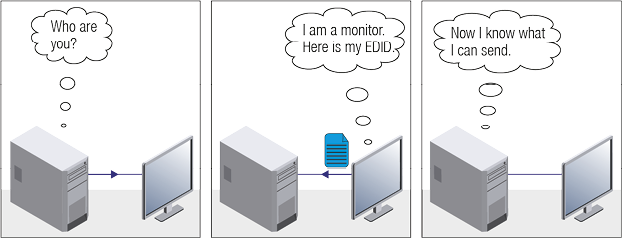
EDID Communication
Most DVI computer displays have 128-byte-long EDID structure. However, Digital Televisions and HDMI capable displays may have another 128 bytes, which is called E-EDID and defined by CEA (Consumer Electronics Association). This extension contains information about additional Detailed Timings, audio capabilities, speaker allocation and HDMI capabilities. It is important to know that all HDMI capable devices must have CEA extension, but not all devices with CEA extension are HDMI capable.
Common Problems Related to EDID
Problem: “My system consists of the following: a computer, a Lightware device, a WUXGA (1920x1200) LCD monitor, and an SXGA (1280x1024) projector. I would like to see the same image on the monitor and the projector. What EDID should I choose on the Lightware device?”
Solution: If you want to see the image on both displays, you need to select the resolution of the smaller display (in this case SXGA), otherwise the smaller display may not show the higher resolution image.
Problem: “I have changed to a different EDID on an input port of the Lightware device to have a different resolution but nothing happens.”
Solution: Some graphics cards and video sources read out the EDID only after power-up, and later they do not sense that EDID has been changed. You need to restart your source to make it read out the EDID again.
9.1.2. Advanced EDID Management
Each DVI sink (e.g. monitors, projectors, plasma displays, etc...) must support the EDID data structure. Source BIOS and operating systems are likely to query the sink using DDC2B protocol to determine what pixel formats and interface are supported. DVI standard uses EDID data structure to identify the monitor type and capabilities. Most DVI sources (VGA cards, set top boxes, etc.) will output DVI signal after accepting the connected sink’s EDID information. In the case of EDID readout failure or missing EDID, the source will not output DVI video signal.
Lightware devices provide the Advanced EDID Management function that helps system integration. The built-in EDID Router can store and emulate factory pre-programmed- and User programmable EDIDs. The EDID of the attached monitors or projectors for each output are stored in a non-volatile memory. This way the EDID of a monitor is available when the monitor is unplugged or switched off.
Any EDID can be emulated on any input. An emulated EDID can be copied from the EDID router’s memory (static EDID emulation), or from the last attached monitor’s memory (dynamic EDID emulation). For example, the Lightware device can be set up to emulate a sink device, which is connected to one of the outputs. In this case, the EDID automatically changes, if the monitor is replaced with another display device (as long as it has a valid EDID).
EDID is independently programmable for all inputs without affecting each other. All inputs have their own EDID circuit.
INFO:The user is not required to disconnect the video cable to change an EDID as opposed to other manufacturer’s products. EDID can be changed even if a source is connected to the input and powered ON.
INFO:When EDID has been changed, the router toggles the HOTPLUG signal for 2 seconds. Some sources do not sense this signal. In such cases, the source device must be restarted or powered OFF and ON again.
9.2. Pixel Accurate Reclocking
Signal reclocking is an essential procedure in digital signal transmission. After passing the reclocking circuit, the signal becomes stable, jitter-free, and can be transmitted over more equipment like processors, or event controllers. Without reclocking, sparkles, noise, and jaggies appear on the image.
Lightware’s sophisticated Pixel Accurate Reclocking technology fixes more problems than general TMDS reclocking. It removes not only intra-pair skew, but inter-pair skew as well. The Pixel Accurate Reclocking circuit eliminates the following errors:
Intra-pair skew
Skew between the + and - wires within a differential wire pair (e.g. Data2- and Data2+). It’s caused by different wire lengths or slightly different wire construction (impedance mismatch) in the DVI cable. It results in jitter.

Inter-pair skew
Skew between two differential wire pairs in a cable. It is caused by different wire pair lengths or different number of twists in the DVI cable. Too much inter-pair skew results in color shift in the picture or sync loss.
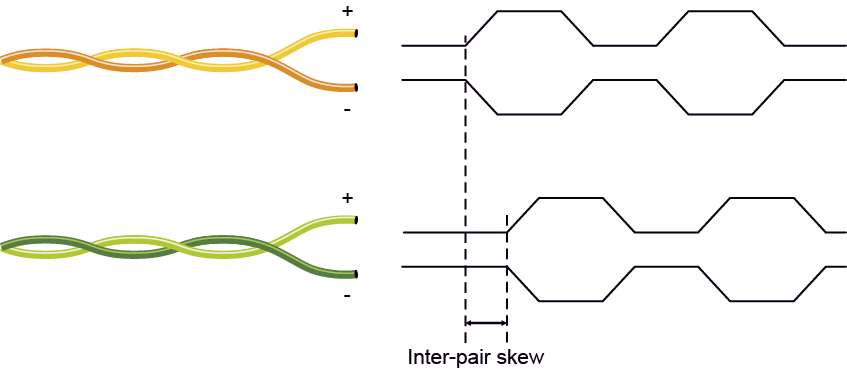
Jitter
Signal instability in the time domain. The time difference between two signal transitions should be a fixed value, but noise and other effects cause variations.

Noise
Electromagnetic interference between other electronic devices such as mobile phones, motors, etc. and the DVI cable are coupled onto the signal. Too much noise results in increased jitter.

INFO:The colors of the wire pairs in the pictures are for illustration and do not represent the color of the actual wires inside the cable.
Tables, drawings, guides, hashtag keyword list and technical details as follows:
10.1. Specification
INFO:Specificatios are subject to change without notice.
10.1.1. HDMI-3D-OPT-TX210DD
General
|
Compliance |
CE, UKCA |
|
EMC (emission) |
EN 55032:2015+A1:2020 |
|
EMC (immunity) |
EN 55035:2017+A11:2020 |
|
RoHS |
EN 63000:2018 |
|
Electrical safety (device) |
EN 62368-1:2020 |
|
Laser safety |
EN 60825-1:2014+A11:2021 |
|
Warranty |
3 years |
|
Operating temperature |
0 to +50˚C (+32 to +122˚F) |
|
Operating humidity |
10% to 90%, non-condensing |
|
Cooling |
Passive |
Power
|
Power supply option |
Power adaptor |
|
Power consumption (maximum) |
7.9W |
|
Heat dissipation (maximum) |
27 BTU/h |
Power Adaptor
|
Supported power source |
100-240 V AC; 50/60 Hz |
|
Supplied power |
5V DC, 1A |
|
AC power plug |
Interchangable (EU, UK, JP/US, AUS/NZ) |
|
DC power plug |
Locking DC connector (2.35 mm pin) |
Enclosure
|
Enclosure material |
1 mm steel |
|
Dimensions in mm |
221 W x 100.4 D x 26 H |
|
Dimensions in inch |
8.7 W x 3.95 D x 1 H |
|
Weight |
605 g (1.33 lbs) |
Video Input
HDMI Input
|
Connector type |
19-pole HDMI Type A receptacle |
|
AV standard |
DVI 1.0, HDMI 1.4 |
|
Color space |
RGB, YCbCr |
|
Supported resolutions at 8 bits/color * |
up to 4096x2048@30Hz (4:4:4) or 4096x2048@60Hz (4:2:0) up to 3840x2160@30Hz (4:4:4) or 3840x2160@60Hz (4:2:0) 1920x1080@60Hz (4:4:4) up to 12 bits/color |
|
Audio formats |
8 channel PCM, Dolby TrueHD DTS-HD Master Audio 7.1 |
Video Output
HDMI Output
|
Connector type |
19-pole HDMI Type A receptacle |
|
AV standard |
DVI 1.0, HDMI 1.4 |
|
Color space |
RGB, YCbCr |
|
Supported resolutions at 8 bits/color * |
up to 4096x2048@30Hz (4:4:4) or 4096x2048@60Hz (4:2:0) up to 3840x2160@30Hz (4:4:4) or 3840x2160@60Hz (4:2:0) 1920x1080@60Hz (4:4:4) up to 12 bits/color |
|
Audio formats |
8 channel PCM, Dolby TrueHD DTS-HD Master Audio 7.1 |
* All standard VESA and CEA resolutions up to 300MHz (HDMI1.4) and other custom resolutions up to 300Mhz are supported.
Fiber Optical Port
|
Connector type |
SC simplex |
|
Fiber type |
50/125 SC Multimode fiber (preferred), 62.5/125 SC Multimode fiber |
|
Laser forward wavelengths |
778; 800; 825; 850 nm |
|
Laser class specification |
Class 3R |
|
Transmitter output OMA * |
-6.25 dBm (worst case) |
|
Receiver OMA * sensitivity |
-14.25 dBm (worst case) |
|
Optical loss budget |
8 dBm (worst case) |
* OMA: Optical Modulation Amplitude
Audio Ports
Analog Audio Input 1
|
Connector type |
3.5 mm TRS (1/8" jack) |
|
Audio formats |
2-ch PCM |
|
Sampling frequency |
48 kHz |
|
Maximum input level |
+0 dBu, 0.77 Vrms, 2.19 Vpp |
|
Signal transmission |
Unbalanced signal |
|
Volume |
-95.62 dB - 0 dB |
|
Balance |
0 - 100 (50 = center) |
|
Gain |
0 dB - 6 dB |
Analog Audio Input 2
|
Connector type |
5-pole Phoenix connector |
|
Audio formats |
2-ch PCM |
|
Sampling frequency |
48 kHz |
|
Maximum input level |
+0 dBu, 0.77 Vrms, 2.19 Vpp |
|
Signal transmission |
Balanced / unbalanced signal |
|
Volume |
-95.62 dB - 0 dB |
|
Balance |
0 - 100 (50 = center) |
|
Gain |
-12 dB - +6 dB |
Control Ports
RS-232 Serial Port
|
Connector type |
3-pole Phoenix connector |
|
Baud rates |
Between 4800 and 115200 BAUD |
|
Data bits |
8 or 9 |
|
Parity |
None / Odd / Even |
|
Stop bits |
1 / 1.5 / 2 |
USB Port
|
Connector type |
USB mini-B type |
|
USB compliance |
USB 2.0 |
10.1.2. HDMI-3D-OPT-RX110DD
General
|
Compliance |
CE, UKCA |
|
EMC (emission) |
EN 55032:2015+A1:2020 |
|
EMC (immunity) |
EN 55035:2017+A11:2020 |
|
RoHS |
EN 63000:2018 |
|
Electrical safety (device) |
EN 62368-1:2020 |
|
Laser safety |
EN 60825-1:2014+A11:2021 |
|
Warranty |
3 years |
|
Operating temperature |
0 to +50˚C (+32 to +122˚F) |
|
Operating humidity |
10% to 90%, non-condensing |
|
Cooling |
Passive |
Power
|
Power supply option |
Power adaptor |
|
Power consumption (maximum) |
6.5 W |
|
Heat dissipation (maximum) |
22.2 BTU/h |
Power Adaptor
|
Supported power source |
100-240 V AC; 50/60 Hz |
|
Supplied power |
5V DC, 1A |
|
AC power plug |
Interchangable (EU, UK, JP/US, AUS/NZ) |
|
DC power plug |
Locking DC connector (2.35 mm pin) |
|
Electrical safety |
EN 62368-1:2014, Class II |
Enclosure
|
Enclosure material |
1 mm steel |
|
Dimensions in mm |
100.4 W x 131.9 D x 26 H |
|
Dimensions in inch |
3.95 W x 5.19 D x 1 H |
|
Weight |
430 g (0.95 lbs) |
Video Output
HDMI Output
|
Connector type |
19-pole HDMI Type A receptacle |
|
AV standard |
DVI 1.0, HDMI 1.4 |
|
Color space |
RGB, YCbCr |
|
Supported resolutions at 8 bits/color * |
up to 4096x2048@30Hz (4:4:4) or 4096x2048@60Hz (4:2:0) |
|
up to 3840x2160@30Hz (4:4:4) or 3840x2160@60Hz (4:2:0) |
|
|
1920x1080@60Hz (4:4:4) up to 12 bits/color |
|
|
Audio formats |
8 channel PCM, Dolby TrueHD |
|
DTS-HD Master Audio 7.1 |
* All standard VESA and CEA resolutions up to 300MHz (HDMI1.4) and other custom resolutions up to 300Mhz are supported.
Fiber Optical Port
|
Connector type |
SC simplex |
|
Fiber type |
50/125 SC Multimode fiber (preferred), 62.5/125 SC Multimode fiber |
|
Laser wavelengths (receives only) |
778; 800; 825; 850 nm |
|
Transmitter output OMA ** |
-6.25 dBm (worst case) |
|
Receiver OMA * sensitivity |
-14.25 dBm (worst case) |
|
Optical loss budget |
8 dBm (worst case) |
** OMA: Optical Modulation Amplitude
Audio Port
Analog Audio Output
|
Connector type |
5-pole Phoenix connector |
|
Audio formats |
2-ch PCM |
|
Sampling frequency |
48 kHz |
|
Signal transmission |
Balanced / unbalanced signal |
|
Volume |
-63 dB - 0 dB |
|
Balance |
0 - 100 (50 = center) |
|
Nominal Differential Output Level @ 0 dB Gain |
+4 dBu |
|
Nominal Differential Output Level @ 3 dB Gain |
+7 dBu |
Control Port
USB Port
|
Connector type |
USB mini-B type |
|
USB compliance |
USB 2.0 |
10.2. Factory Default Settings
10.2.1. HDMI-3D-OPT-TX210DD
|
Parameter |
Setting/Value |
|
Video output port settings (optical link and local HDMI) |
|
|
Test pattern mode |
Off |
|
Test pattern resolution |
480p |
|
Test pattern |
Bar |
|
Signal type |
Auto |
|
Laser enable |
On |
|
Analog audio input port properties |
|
|
Volume |
0.00 dB |
|
Balance |
0 (center) |
|
Gain |
0.00 dB |
|
RS-232 settings |
|
|
Control protocol |
LW2 |
|
Baud rate / Databits / Parity / Stopbits |
57600 / 8 / No / 1 |
10.2.2. HDMI-3D-OPT-RX110DD
|
Parameter |
Setting/Value |
|
HDMI output port properties |
|
|
Signal type |
Auto |
|
Power 5V mode |
Always on |
|
Test pattern mode |
Off |
|
Test pattern resolution |
480p |
|
Test pattern |
Bar |
|
Analog audio output port properties |
|
|
Volume |
0.00 dB (100%) |
|
Balance |
0 (center) |
|
Bass |
0.00 dB |
|
Treble |
0.00 dB |
|
Phase invert |
Disabled |
The following tables contain the input and output ports with their ID numbers, which shall be used when protocol command sending or in Lightware Device Controller (LDC).
HDMI-3D-OPT-TX210DD
|
Port name |
Video port number |
Emulated EDID memory |
Audio port number |
||
|
LW2 |
LW3 |
LW2 |
LW3 |
||
|
HDMI in |
01 |
I1 |
E1 |
01 |
I1 |
|
Audio1 in |
- |
- |
- |
02 |
I2 |
|
Audio2 in |
- |
- |
- |
03 |
I3 |
|
Optical link out |
01 |
O1 |
- |
01 |
O1 |
|
Local HDMI out |
02 |
O2 |
- |
02 |
O2 |
HDMI-3D-OPT-RX110DD
|
Port name |
Video port number |
Emulated EDID memory |
Audio port number |
||
|
LW2 |
LW3 |
LW2 |
LW3 |
||
|
Optical link in |
01 |
I1 |
E1 |
01 |
I1 |
|
HDMI out |
01 |
O1 |
- |
01 |
O1 |
|
Analog audio out |
- |
- |
- |
02 |
O2 |
10.4. Maximum Fiber Cable Extensions
|
OM1 |
OM2 |
OM3 |
OM4 |
|
|
(62.5/125) |
(50/125) |
(50/125) |
(50/125) |
|
|
1080p@60Hz 24 bpp |
250 m |
600 m |
1200 m |
2500 m |
|
1080p@60Hz 36 bpp |
150 m |
400 m |
800 m |
1300 m |
|
4096x2048@30Hz 24 bpp |
Not supported |
350 m |
700 m |
1100 m |
10.5.1. HDMI-3D-OPT-TX210DD
The following drawings present the physical dimensions of the transmitter. Dimensions are in mm.
Bottom View

Front View

Top View

Rear View

Side View

10.5.2. HDMI-3D-OPT-RX110DD
The following drawings present the physical dimensions of the receiver. Dimensions are in mm.
|
Front View |
Rear View |

|

|
|
Bottom View |
Top View |

|

|
|
Mem |
Resolution |
Type |
EDID audio features |
|||
|
F1 |
640 x |
480p |
@ 60.00 |
Hz |
D |
|
|
F2 |
848 x |
480p |
@ 60.00 |
Hz |
D |
|
|
F3 |
800 x |
600p |
@ 60.32 |
Hz |
D |
|
|
F4 |
1024 x |
768p |
@ 60.00 |
Hz |
D |
|
|
F5 |
1280 x |
768p |
@ 50.00 |
Hz |
D |
|
|
F6 |
1280 x |
768p |
@ 59.94 |
Hz |
D |
|
|
F7 |
1280 x |
768p |
@ 75.00 |
Hz |
D |
|
|
F8 |
1360 x |
768p |
@ 60.02 |
Hz |
D |
|
|
F9 |
1280 x |
1024p |
@ 50.00 |
Hz |
D |
|
|
F10 |
1280 x |
1024p |
@ 60.02 |
Hz |
D |
|
|
F11 |
1280 x |
1024p |
@ 75.02 |
Hz |
D |
|
|
F12 |
1400 x |
1050p |
@ 50.00 |
Hz |
D |
|
|
F13 |
1400 x |
1050p |
@ 60.00 |
Hz |
D |
|
|
F14 |
1400 x |
1050p |
@ 75.00 |
Hz |
D |
|
|
F15 |
1680 x |
1050p |
@ 60.00 |
Hz |
D |
|
|
F16 |
1920 x |
1080p |
@ 50.00 |
Hz |
D |
|
|
F17 |
1920 x |
1080p |
@ 60.00 |
Hz |
D |
|
|
F18 |
2048 x |
1080p |
@ 50.00 |
Hz |
D |
|
|
F19 |
2048 x |
1080p |
@ 60.00 |
Hz |
D |
|
|
F20 |
1600 x |
1200p |
@ 50.00 |
Hz |
D |
|
|
F21 |
1600 x |
1200p |
@ 60.00 |
Hz |
D |
|
|
F22 |
1920 x |
1200p |
@ 50.00 |
Hz |
D |
|
|
F23 |
1920 x |
1200p |
@ 59.56 |
Hz |
D |
|
|
F24 |
2048 x |
1200p |
@ 59.96 |
Hz |
D |
|
|
F29 |
1920 x |
1080p |
@ 60.00 |
Hz |
U |
|
|
F30 |
1440 x |
480i |
@ 60.05 |
Hz |
H |
2chLPCM |
|
F31 |
1440 x |
576i |
@ 50.08 |
Hz |
H |
2chLPCM |
|
F32 |
640 x |
480p |
@ 59.95 |
Hz |
H |
2chLPCM |
|
F33 |
720 x |
480p |
@ 59.94 |
Hz |
H |
2chLPCM |
|
F34 |
720 x |
576p |
@ 50.00 |
Hz |
H |
2chLPCM |
|
F35 |
1280 x |
720p |
@ 50.00 |
Hz |
H |
2chLPCM |
|
F36 |
1280 x |
720p |
@ 60.00 |
Hz |
H |
2chLPCM |
|
F37 |
1920 x |
1080i |
@ 50.04 |
Hz |
H |
2chLPCM |
|
F38 |
1920 x |
1080i |
@ 50.00 |
Hz |
H |
2chLPCM |
|
F39 |
1920 x |
1080i |
@ 60.05 |
Hz |
H |
2chLPCM |
|
F40 |
1920 x |
1080i |
@ 60.05 |
Hz |
H |
2chLPCM |
|
F41 |
1920 x |
1080p |
@ 24.00 |
Hz |
H |
2chLPCM |
|
F42 |
1920 x |
1080p |
@ 25.00 |
Hz |
H |
2chLPCM |
|
F43 |
1920 x |
1080p |
@ 30.00 |
Hz |
H |
2chLPCM |
|
F44 |
1920 x |
1080p |
@ 50.00 |
Hz |
H |
2chLPCM |
|
F45 |
1920 x |
1080p |
@ 60.00 |
Hz |
H |
2chLPCM |
|
F46 |
1920 x |
1080p |
@ 60.00 |
Hz |
H |
2chLPCM |
|
F47 |
1920 x |
1080p |
@ 60.00 |
Hz |
U |
2chLPCM |
|
F48 |
1920 x |
1080p |
@ 60.00 |
Hz |
U |
2chLPCM, 8chLPCM, DD, DTS, AAC, DD+, DTS-HD, MLP, DST, WMAP |
|
F49 |
1920 x |
1080p |
@ 60.00 |
Hz |
U |
2chLPCM, 8chLPCM, DD, DTS, AAC, DD+, DTS-HD, MLP, DST, WMAP |
|
F90 |
1920 x |
2160p |
@ 59.99 |
Hz |
D |
|
|
F91 |
1024 x |
2400p |
@ 60.01 |
Hz |
D |
|
|
F94 |
2048 x |
1536p |
@ 60.00 |
Hz |
D |
|
|
F96 |
2560 x |
1600p |
@ 59.86 |
Hz |
D |
|
|
F97 |
3840 x |
2400p |
@ 24.00 |
Hz |
D |
|
|
F98 |
1280 x |
720p |
@ 60.00 |
Hz |
H |
2chLPCM |
|
F99 |
1920 x |
1080p |
@ 60.00 |
Hz |
H |
2chLPCM |
|
F100 |
1024 x |
768p |
@ 60.00 |
Hz |
H |
2chLPCM |
|
F101 |
1280 x |
1024p |
@ 50.00 |
Hz |
H |
2chLPCM |
|
F102 |
1280 x |
1024p |
@ 60.02 |
Hz |
H |
2chLPCM |
|
F103 |
1280 x |
1024p |
@ 75.02 |
Hz |
H |
2chLPCM |
|
F104 |
1600 x |
1200p |
@ 50.00 |
Hz |
H |
2chLPCM |
|
F105 |
1600 x |
1200p |
@ 60.00 |
Hz |
H |
2chLPCM |
|
F106 |
1920 x |
1200p |
@ 59.56 |
Hz |
H |
2chLPCM |
|
F107 |
2560 x |
1440p |
@ 59.95 |
Hz |
H |
2chLPCM |
|
F108 |
2560 x |
1600p |
@ 59.86 |
Hz |
H |
2chLPCM |
|
F109 |
3840 x |
2400p |
@ 24.00 |
Hz |
H |
2chLPCM |
|
F110 |
3840 x |
2160p |
@ 24.00 |
Hz |
H |
2chLPCM |
|
F111 |
3840 x |
2160p |
@ 25.00 |
Hz |
H |
2chLPCM |
|
F112 |
3840 x |
2160p |
@ 30.00 |
Hz |
H |
2chLPCM |
|
F118 |
3840 x |
2160p |
@ 30.00 |
Hz |
U |
2chLPCM |
|
F119 |
3840 x |
2160p |
@ 30.00 |
Hz |
U |
2chLPCM, 8chLPCM, DD, DTS, AAC, DD+, DTS-HD, MLP, DST, WMAP |
|
F120 |
3840 x |
2160p |
@ 60.00 |
Hz |
H |
2chLPCM |
|
F121 |
1440 x |
1080p |
@ 59.91 |
Hz |
H |
2chLPCM |
|
F122 |
2560 x |
2048p |
@ 59.98 |
Hz |
H |
2chLPCM |
|
F123 |
1280 x |
800p |
@ 59.91 |
Hz |
H |
2chLPCM |
|
F124 |
1440 x |
900p |
@ 59.90 |
Hz |
H |
2chLPCM |
|
F125 |
1368 x |
768p |
@ 59.85 |
Hz |
H |
2chLPCM |
|
F126 |
1600 x |
900p |
@ 59.98 |
Hz |
H |
2chLPCM |
|
F127 |
2048 x |
1080p |
@ 60.00 |
Hz |
H |
2chLPCM |
|
F128 |
2560 x |
1080p |
@ 60.00 |
Hz |
H |
2chLPCM |
|
F129 |
3440 x |
1440p |
@ 24.99 |
Hz |
H |
2chLPCM |
|
F130 |
3440 x |
1440p |
@ 29.99 |
Hz |
H |
2chLPCM |
|
F131 |
4096 x |
2160p |
@ 25.00 |
Hz |
H |
2chLPCM |
|
F132 |
4096 x |
2160p |
@ 30.00 |
Hz |
H |
2chLPCM |
|
F133 |
4096 x |
2160p |
@ 60.00 |
Hz |
H |
2chLPCM |
|
F134 |
3440 x |
1440p |
@ 23.99 |
Hz |
H |
2chLPCM |
|
F135 |
4096 x |
2160p |
@ 24.00 |
Hz |
H |
2chLPCM |
|
F136 |
3840 x |
2400p |
@ 29.99 |
Hz |
H |
2chLPCM |
The legend for the table can be found on the next page.
D: DVI EDID
H: HDMI EDID
U: Universal EDID, supporting many standard resolutions:
▪F29: Universal EDID for DVI signals (no audio support).
▪F47: HDMI EDID supporting PCM audio.
▪F48: HDMI EDID supporting all type of audio.
▪F49: HDMI EDID supporting all type of audio and deep color.
▪F89: Universal EDID for analog signals (no audio support).
▪F118: HDMI EDID supporting PCM audio and 4K@30 Hz signals.
▪F119: HDMI EDID supporting all type of audio and 4K@30 Hz signals.
DiD (in column EDID features): with Display ID support
Please note that minor changes in the factory EDID list may be applied in further firmware versions.
The backup file contains numerous settings and parameters saved from the device. When the file is uploaded to a device, the following will be overwritten:
|
General |
|
Device label, Control (button) lock |
|
HDMI input port |
|
Video port name, Audio port name |
|
Analog audio input ports |
|
Volume, Balance, Gain, Port name |
|
Crosspoint settings |
|
Audio crosspoint setting, Audio autoselect settings, Mute ports, Lock ports |
|
Optical output port |
|
Video port name, Audio port name |
|
Test pattern mode, clock source and type |
|
HDMI mode |
|
Local output port |
|
Port name, HDMI mode, Power +5V mode |
|
Test pattern mode, clock source, and type |
|
Serial port |
|
Control protocol, Baud rate, Data bits, Stop bits, Parity |
|
Further settings |
|
User EDID data (Transmitter: U1-U14; Receiver: U1-U15) |
|
Event manager: settings of all Events (E1-E20) |
For the description of backup/restore procedure, see the Configuration Cloning (Backup Tab) section.
Inputs and outputs of audio devices are symmetric or asymmetric. The main advantage of the symmetric lines is the better protection against the noise, therefore, they are widely used in the professional audio industry. Symmetric audio is most often referred to as balanced audio, as opposed to asymmetric, which is referred to as unbalanced audio. Ligthware products are usually built with 5-pole Phoenix connectors, so we would like to help users assembling their own audio cables. See the most common cases below.
ATTENTION!Symmetric and asymmetric lines can be linked with passive accessories (e.g. special cables), but in this case half of the line level is lost.
ATTENTION!There are numerous types of regularly used connector and cable types to connect audio devices. Please always make sure that a connector or cable fits your system before use.
ATTENTION!Never join the phase-inverted (negative, cold or -) poles (either right and left) to the ground or to each other on the output side, as this can damage the unit.
INFO:Use a galvanic isolation in case of a ground loop.
10.8.1. Serial Ports
The device is built with 3-pole Phoenix connector. See the examples below of connecting to a DCE (Data Circuit-terminating Equipment) or a DTE (Data Terminal Equipment) type device:
|
Lightware device and a DCE D-SUB 9 and Phoenix |
Lightware device and a DTE D-SUB 9 and Phoenix |

|
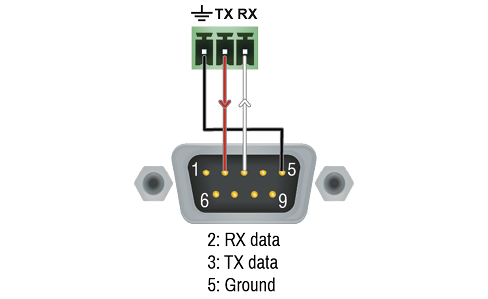
|
The Pinout of the 5-pole Phoenix Connector

Compatible Plug Type: Phoenix® Combicon series (3.5mm pitch, 5-pole), type: MC 1.5/5-ST-3.5.
From Unbalanced Output to Balanced Input
|
2 x 6.3 (1/4") TS - Phoenix |
2 x RCA - Phoenix |
3.5 (1/8") TRS - Phoenix |
||

|

|

|
From Balanced Output to Unbalanced Input
|
Phoenix - 2 x 6.3 (1/4") TS |
Phoenix - 2 x RCA |
Phoenix - 3.5 (1/8") TRS |
||

|

|

|
From Balanced Output to Balanced Input
|
Phoenix - 2 x 6.3 (1/4") TRS |
Phoenix - 2 x XLR |
2 x 6.3 TRS (1/4") - Phoenix |
||
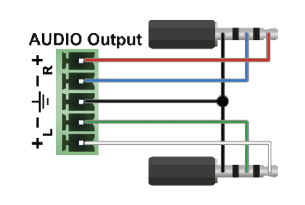
|
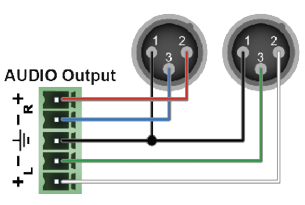
|
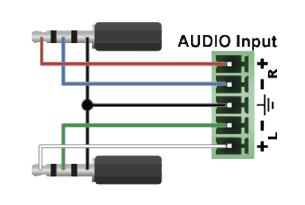
|
||
|
2 x XLR - Phoenix |
Phoenix - Phoenix |
|||

|

|
10.9. Release Notes of the Firmware Packages
The following list below shows the released firmware packages with important notes.
10.9.1. Transmitter
v1.2.1b3
Release date: 2023-01-24
Bugfix:
▪Fixed a bug that resulted the product restarts when connected to an Ethernet network.
v1.2.0b7
Release date: 2022-09-06
New feature:
▪Support new product: HDMI-3D-OPT-TX210DD
v1.1.1b5
Release date: 2020-02-12
New feature:
▪Manufacturing support.
v1.1.0b7
Release date: 2019-10-28
10.9.2. Receiver
v2.1.1b2
Release date: 2023-01-24
Bugfix:
▪Fixed a bug that resulted the product only responded to every second request on the serial port.
v2.1.0b7
Release date: 2022-09-06
New feature:
▪Support new product: HDMI-3D-OPT-RX110DD
v2.0.1b2
Release date: 2019-10-28
Bugfix:
▪Manufacturing support.
v1.0.1b1
Release date: 2012-09-01
10.10. Hashtag Keyword List
This user's manual contains keywords with hashtag (#) to help you to find the relevant information as quick as possible.
The format of the keywords is the following:
#<keyword>
The usage of the keywords: use the Search function (Ctrl+F / Cmd+F) of your PDF reader application, type the # (hashtag) character and the wished keyword.
The #new special keyword indicates a new feature/function that has just appeared in the latest firmware or software version.
Example
#diagnostic
This keyword is placed at the Diagnostic Tools section in the Lightware Device Controller (LDC) chapter where the description of the Frame detector and Test pattern tools can be found.
The following list contains all hashtag keywords placed in the document with a short description belonging to them. The list is in alphabetical order by the hashtag keywords.
|
Hashtag Keyword |
Description |
|
#advancedview |
Advanced view / Terminal window |
|
#analogaudio |
Analog audio related settings |
|
#audio |
Audio related settings |
|
#autoselect |
Autoselect feature settings |
|
#backup |
Configuration cloning (backup) |
|
#balance |
Balance (for analog audio) setting |
|
#bootload |
Bootload mode setting |
|
#button |
Front panel button related setting |
|
#configurationcloning |
Configuration cloning (backup) |
|
#controllock |
Button lock setting |
|
#crosspoint |
Crosspoint switch setting |
|
#devicelabel |
Device label |
|
#diagnostic |
Failure diagnostic related tool/information |
|
#edid |
EDID related settings |
|
#eventmanager |
Event manager |
|
#factory |
Factory default settings |
|
#firmwareversion |
Firmware version query |
|
#framedetector |
Frame detector in LDC |
|
#frontpanel |
Front panel button related setting |
|
#function |
Function button |
|
#gain |
Gain (for analog audio) setting |
|
#label |
Device label |
|
#lock |
Port lock setting |
|
#lockbutton |
Front panel button lock setting |
|
#log |
System log |
|
#mute |
Port mute setting |
|
#optical |
Fiber optical port related settings |
|
#portstatus |
Source/destination port status query |
|
#producttype |
Product type query |
|
#protocol |
RS-232 protocol setting |
|
#reboot |
Restarting the device |
|
#restart |
Restarting the device |
|
#rs232 |
RS-232 related settings |
|
#rs-232 |
RS-232 related settings |
|
#serial |
RS-232 related settings |
|
#serialnumber |
Serial number query |
|
#showme |
Show Me button |
|
#signaltype |
HDMI/DVI signal type setting |
|
#status |
Status query |
|
#switch |
Crosspoint switch setting |
|
#systemlog |
System log |
|
#terminal |
Advanced view / Terminal window |
|
#testpattern |
Test pattern (no sync screen) settings |
|
#unlock |
Port unlock setting |
|
#unmute |
Port unmute setting |
|
#volume |
Volume (for analog audio) setting |
10.11. Further Information
Limited Warranty Statement
1. Lightware Visual Engineering LLC (Lightware) warrants to all trade and end user customers that any Lightware product purchased will be free from manufacturing defects in both material and workmanship for three (3) years from purchase unless stated otherwise below. The warranty period will begin on the latest possible date where proof of purchase/delivery can be provided by the customer. In the event that no proof can be provided (empty ‘Date of purchase’ field or a copy of invoice), the warranty period will begin from the point of delivery from Lightware.
1.1. 25G and MODEX product series will be subject to a seven (7) year warranty period under the same terms as outlined in this document.
1.2. If during the first three (3) months of purchase, the customer is unhappy with any aspect of a Lightware product, Lightware will accept a return for full credit.
1.3. Any product that fails in the first six (6) months of the warranty period will automatically be eligible for replacement and advanced replacement where available. Any replacements provided will be warranted for the remainder of the original unit’s warranty period.
1.4. Product failures from six (6) months to the end of the warranty period will either be repaired or replaced at the discretion of Lightware. If Lightware chooses to replace the product, then the replacement will be warranted for the remainder of the original unit’s warranty period.
2. The above-stated warranty and procedures will not apply to any product that has been:
2.1. Modified, repaired or altered by anyone other than a certified Lightware engineer unless expressly agreed beforehand.
2.2. Used in any application other than that for which it was intended.
2.3. Subjected to any mechanical or electrical abuse or accidental damage.
2.4. Any costs incurred for repair/replacement of goods that fall into the above categories (2.1., 2.2., 2.3.) will be borne by the customer at a pre-agreed figure.
3. All products to be returned to Lightware require a return material authorization number (RMA) prior to shipment, and this number must be clearly marked on the box. If an RMA number is not obtained or is not clearly marked on the box, Lightware will refuse the shipment.
3.1. The customer will be responsible for in-bound and Lightware will be responsible for out-bound shipping costs.
3.2. Newly repaired or replaced products will be warranted to the end of the originally purchased product's warranty period.
Document Revision History
|
Rev. |
Release date |
Changes |
Editor |
|
1.0 |
16-03-2022 |
Initial release |
Tamas Forgacs |
|
. . . |
|||
|
1.2 |
08-12-2022 |
Minor corrections for HTML export |
Tamas Forgacs |
|
1.3 |
15-01-2024 |
Specifications updated |
Tamas Forgacs |
Contact Us
+36 1 255 3800
+36 1 255 3810
Lightware Visual Engineering LLC.
Peterdy 15, Budapest H-1071, Hungary
©2024 Lightware Visual Engineering. All rights reserved. All trademarks mentioned are the property of their respective owners. Specifications subject to change without notice.



























